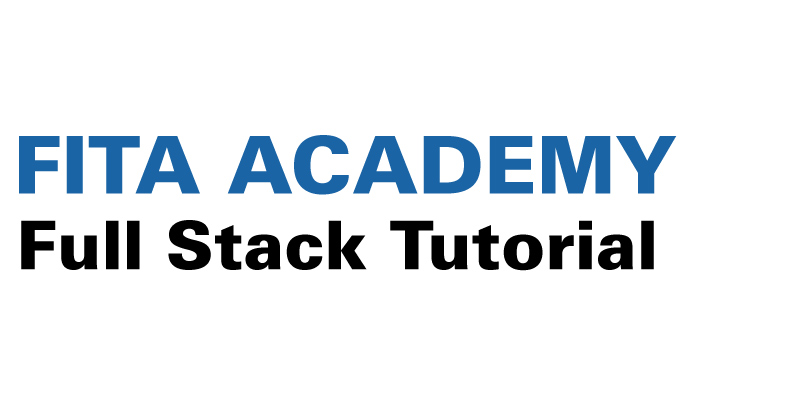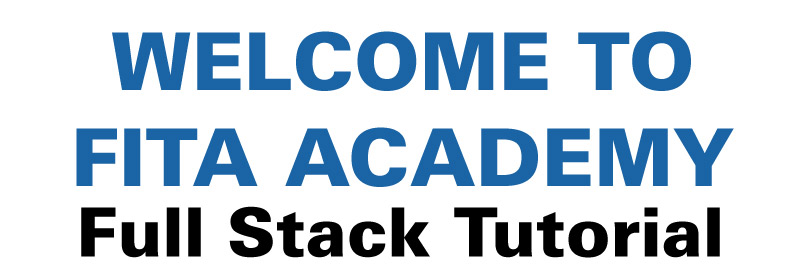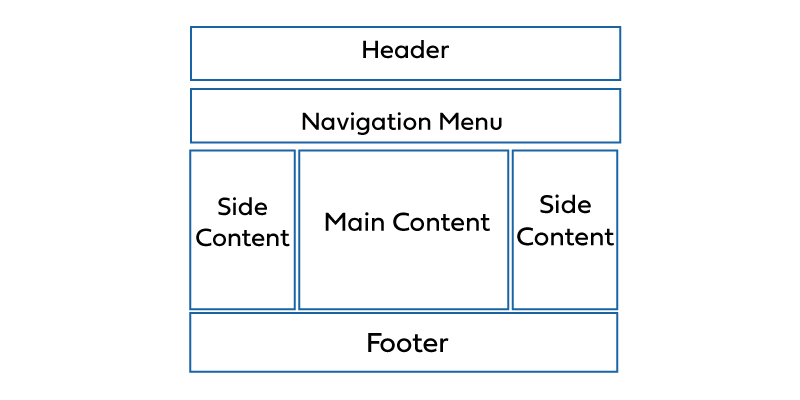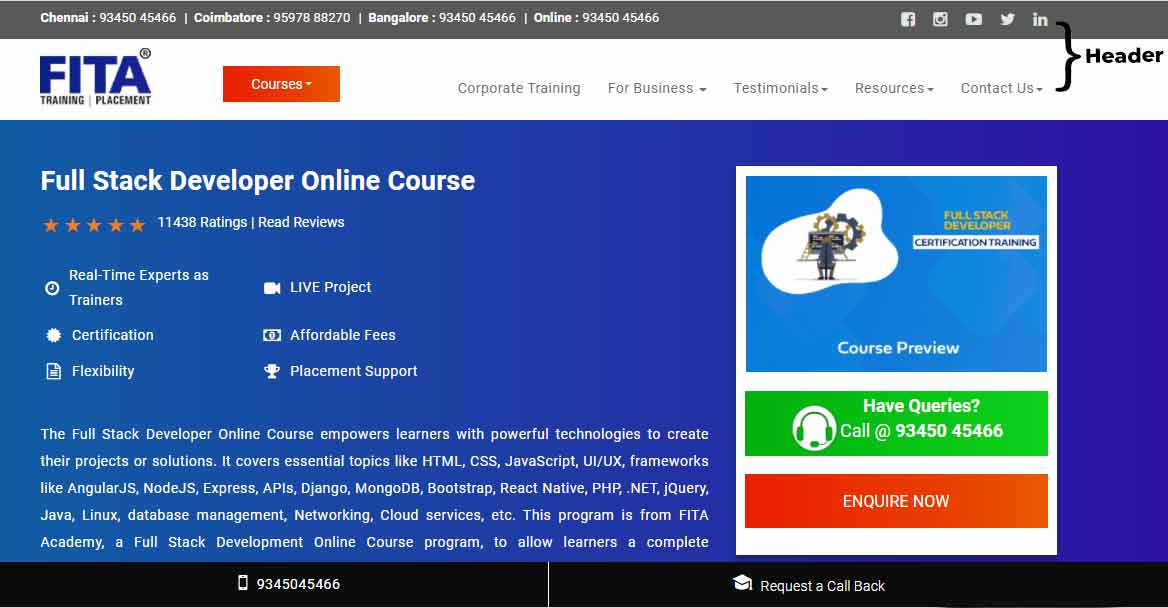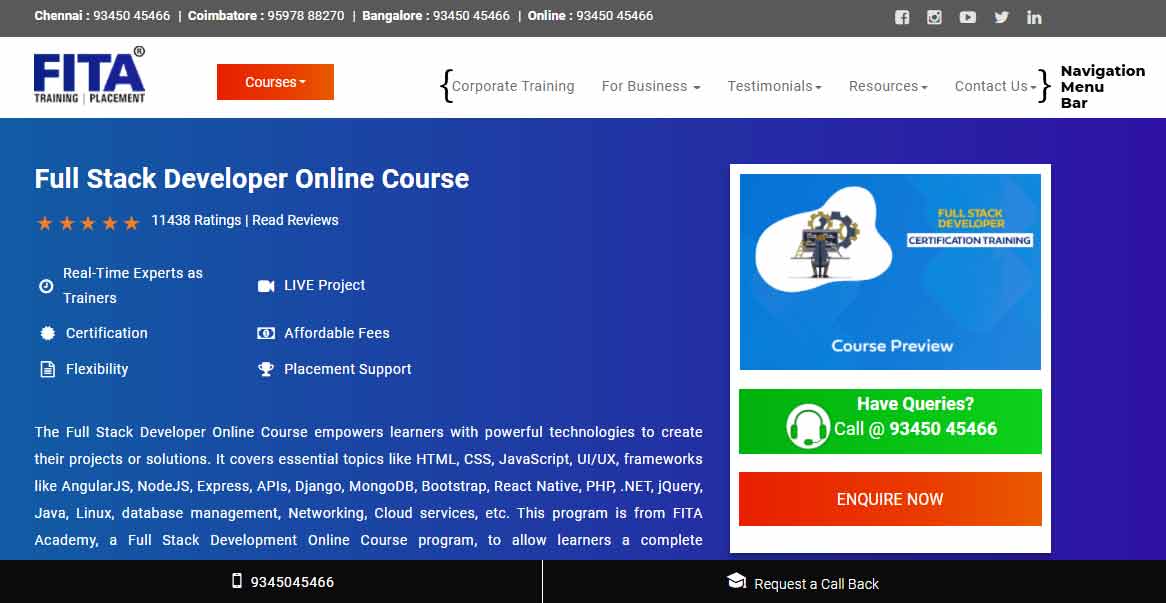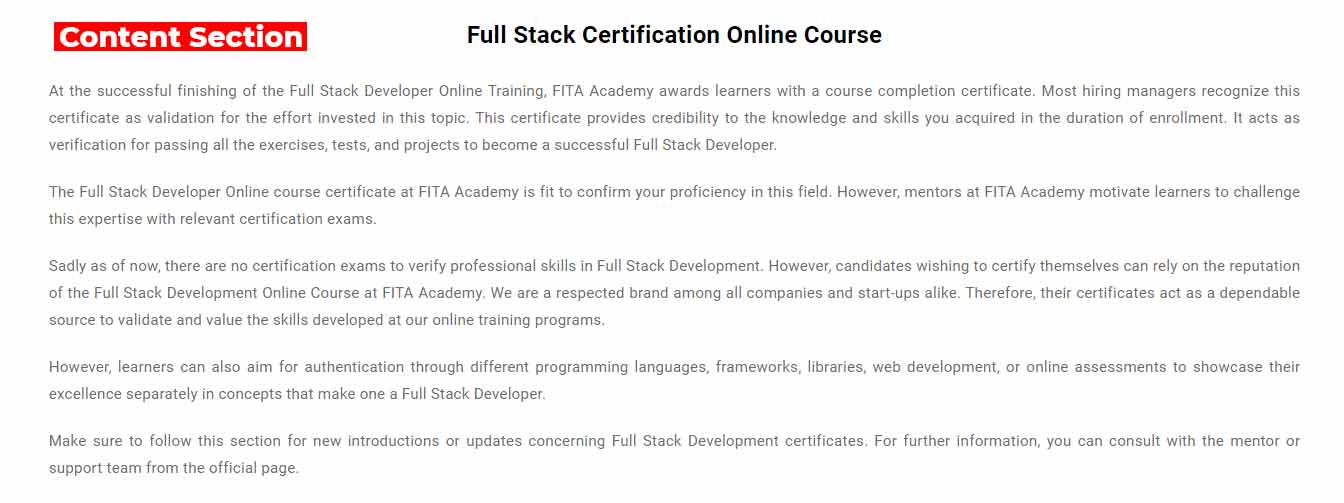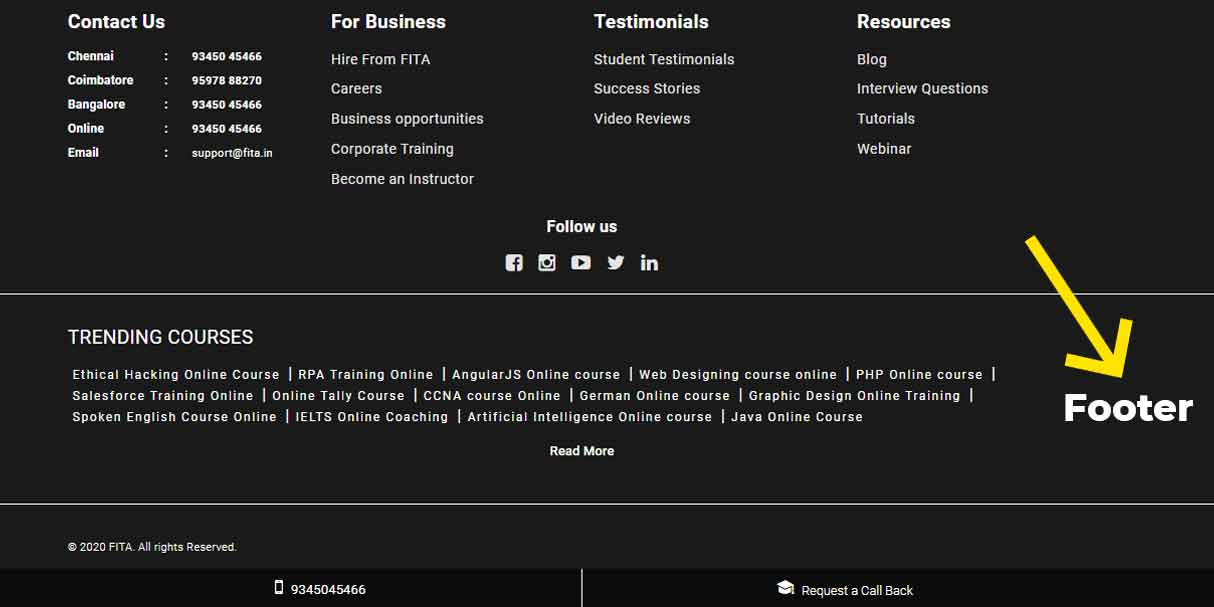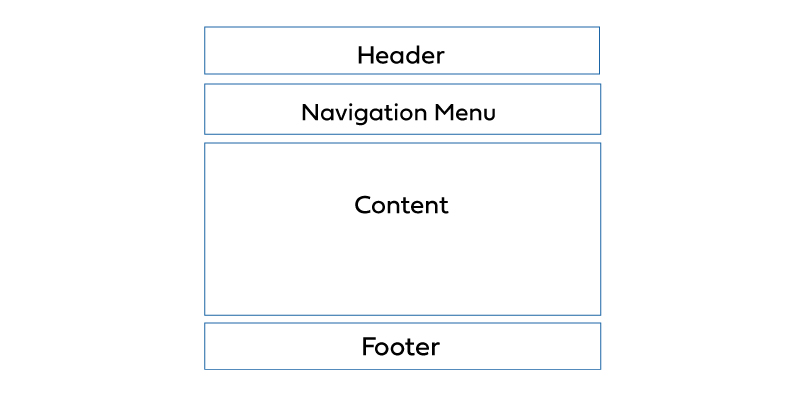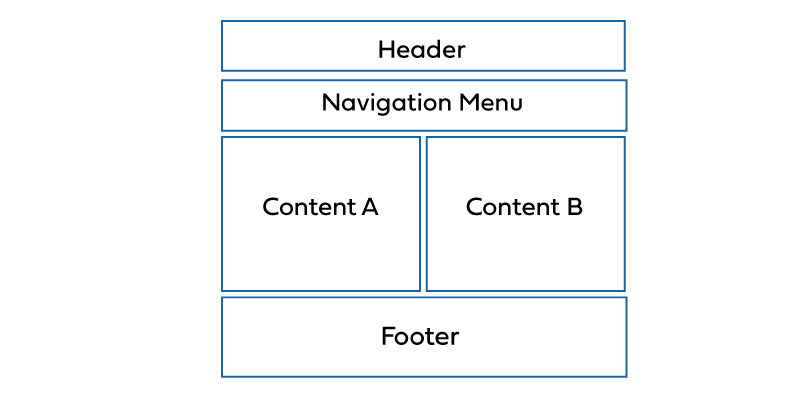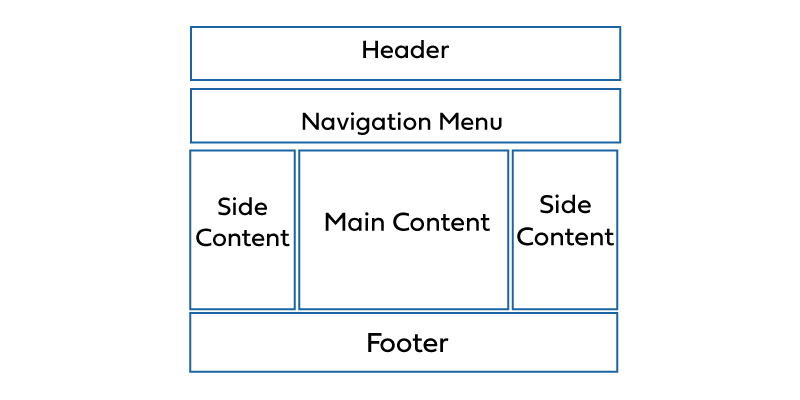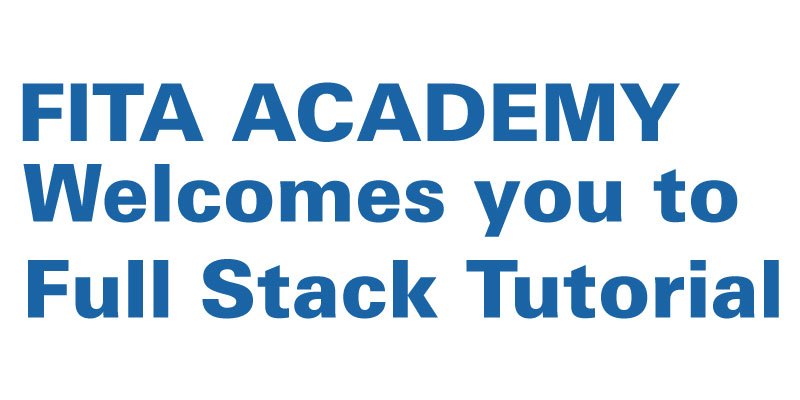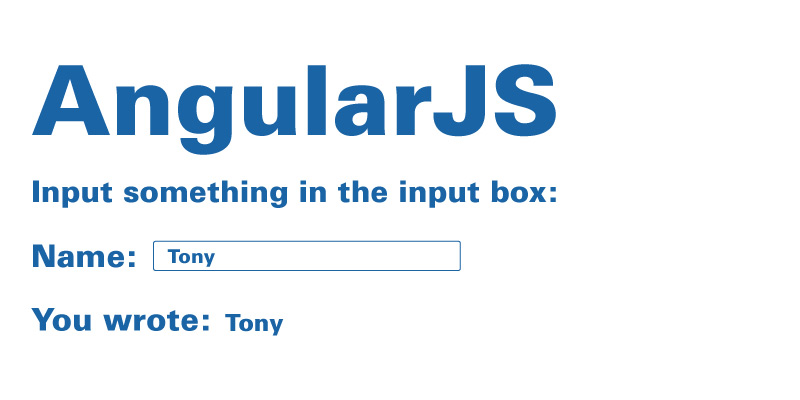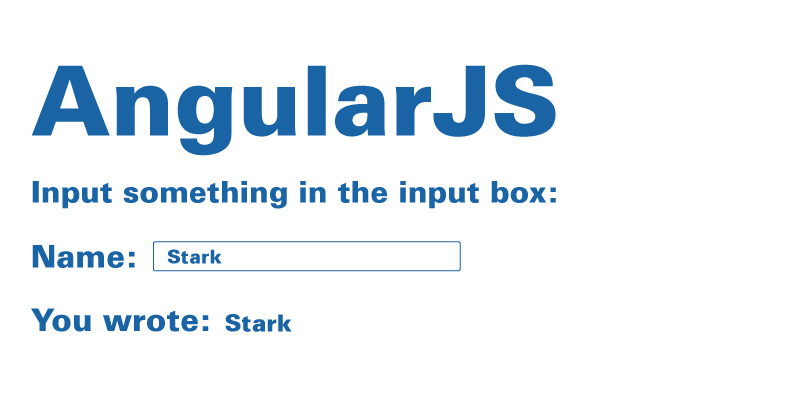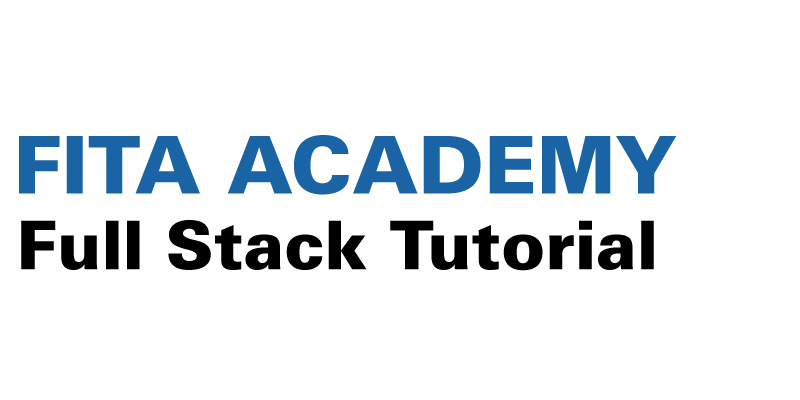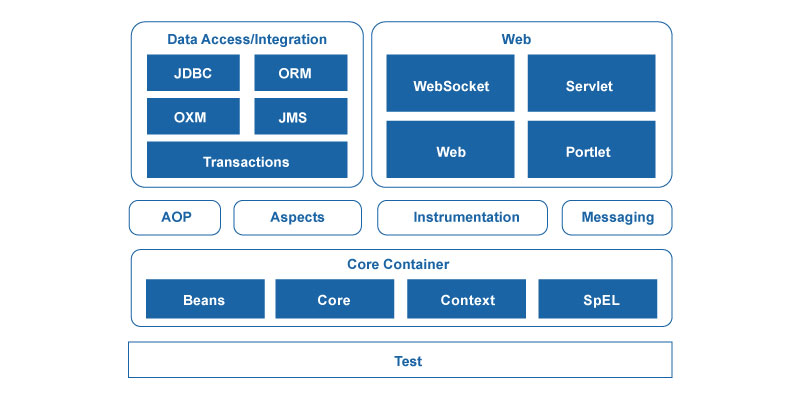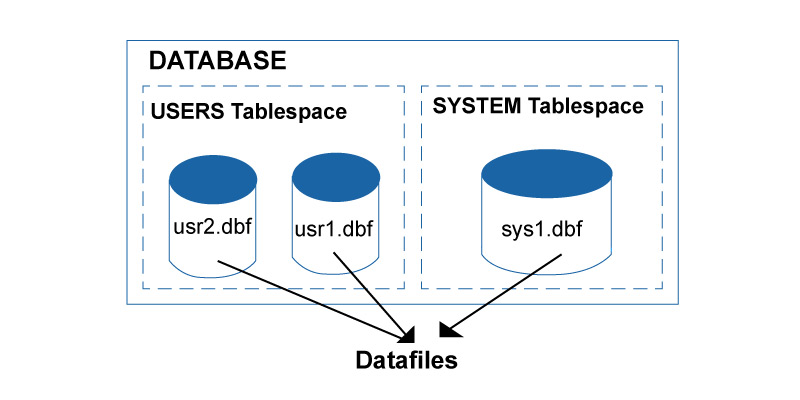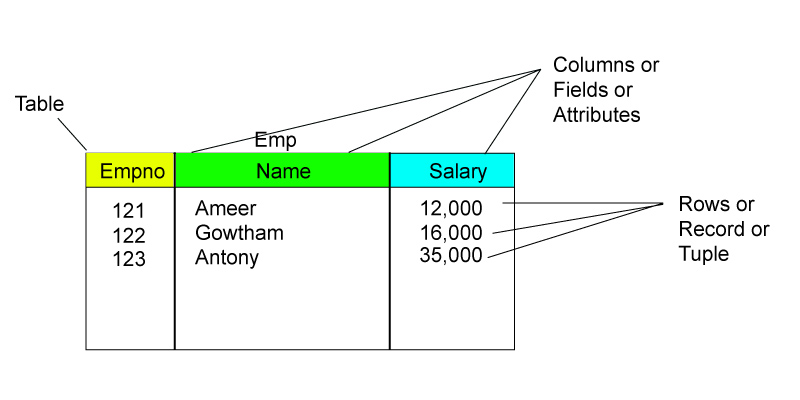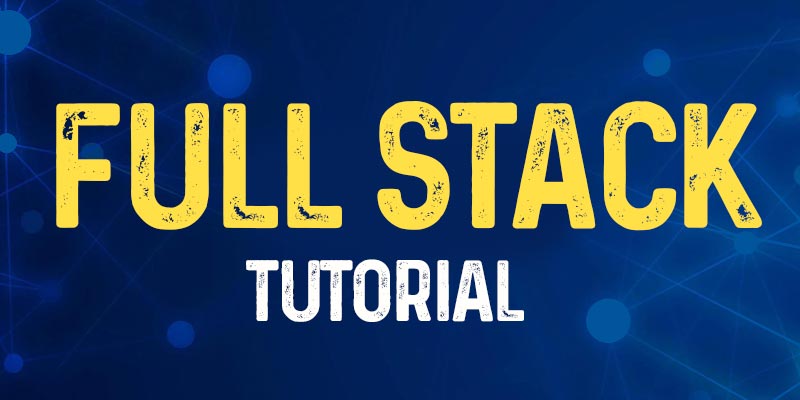
Overview
Modern days Web Development is both alluring and a highly demanding field. The Frontend Frameworks, the Backend Frameworks, and the Deployment solutions persistently evolve with the never-ending strife to battle the augment of Web Software Engineering. With more groundbreaking innovation that is taking place in this field, it is important for the aspirants who are seeking to begin their careers in the Web development field to keep updated and to sustain themselves in this competitive world. Here in this Full Stack Developer Tutorial, we will drive you extensively on the popular stacks and the technologies that are involved in them.
Intended Audiences: This Full Stack Developer Tutorial is a skillfully crafted Full Stack Tutorial series accommodating both the novice and the senior-level developers in mind. This Full Stack Developer Tutorial acts as an instrument in equipping the learners to become familiar with the Full Stack concepts in a sequential manner.
Prerequisites: Full Stack does not need any prerequisites in specific as the Full Stack itself entails all the concepts right from the basics to the advanced level. However, having a fundamental idea or outline of the Web Application Development process will be of added advantage for you to comprehend the concepts at ease.
Getting to know about Full Stack
What is Full Stack Web Development?
The Full Stack Web Development refers to the process of both the Front-end and Back-end process of the application. A Web Development process includes three layers. The Presentation Layer with the front and user interface aspects. The Business Logic Layer is concerned with the backend and data validation along with the Database layer.
Now, let us have a glimpse of these three layers of the Web Application Development process.
Presentation Layer: This layer is also called the Front-end layer and this consists of everything that deals with the end-users directly. Currently, the presentation layer is developed using HTML, JavaScript, CSS, jQuery, and other important JavaScript libraries namely AngularJS, ReactJS, Backbone, and EmberJS.
Logical Layer: This layer is also called the Back-end layer. The Logic Layer primarily deals with the process of application development which doesn't involve the User interface. The Logic layer includes everything that the Core logic should make it function. The Backend developers are professionals who are affluent in the programming languages namely Java, Python, Ruby, Dot Net, and PHP.
Data Layer: This is at times is termed as the Sub-group of a Logic layer. The Data Layer primarily deals with how the data are read, created, updated, and deleted using the databases namely SQL Server, PostgreSQL, MySQL, and Oracle.
A Full Stack Developer is a professional who takes complete care of all the process that is involved right from the conception of the idea till the execution of the finished product.
Who is a Full Stack Developer?
The Full Stack Web Developer is a person who has a sound understanding of how the Web functions at every level right from the setup process to the configuration of the Windows or the Linux servers to coding different server-side APIs and operating the client-side application using the Javascript, querying databases and operating, designing and structuring the Web page using the HTML and CSS.
In a Nutshell, the Full Stack Developer is the person who can work on both the Frontend, Backend, Debugging, and Databases process of the Website or the Web page application.
In this Full Stack Developer Tutorial for Beginners let us see in detail the skills and knowledge that are required for a Full Stack Developer.
- The Developer should be proficient with the System Infrastructure that includes the Operating systems and Hardware
- The Developer should have commendable knowledge of the Front End technologies such as HTML, CSS, and JavaScript
- The Full-Stack Developer should be capable of building dynamic UI with the aid of the JavaScript Frameworks like AngularJS, ReactJS, Vue JS, and Ember.
- The Full-Stack Developer should have sound knowledge of Code Server-side APIs and the Backend programming languages such as PHP, Java, Python, and Ruby along with the Node.js framework.
- This operates and handles the Relational Database Management System such as SQL, MongoDB, and MySQL.
- The Developer should be more proficient with the Project Management and Client Coordination tools.
The above is the general requirements that are needed for a Full Stack Developer. However, the requirements may defer according to the stacks that one pursues.
Some of the Popular Stacks are
- MEAN STACK: MongoDB-Express-AngularJS-Node.js
- LAMP STACK: Linux-Apache-MySQL-PHP
- LEMP STACK: JavaScript- Linux-Nginx-MySQL-PHP
- Ruby on Rails: JavaScript-Ruby-SQLite-Rails
- Django STACK: JavaScript- Python-Django-MySQL
Client-Side Server technologies(Front-end): HTML, CSS, Javascript, Bootstrap, ES5, W3.CSS, React XML, HTML DOM, JSON, jquery, Angular, Ember, Backbone.js, Redux, Storybook, Grunt, GraphQL, Gulp, and Meteor.js.
Server-side (Back End technologies)
PHP, C++, C#, ASP, Java, Python, Express.js, GO, REST, Ruby, SQL, SaaS, MongoDB, PaaS, Node.js, Firebase.com, Less, (Heroku and Azure), and Parse.com.
For anyone who has no prior experience or knowledge who works directly with the Web Development concepts such as Front-end and Back-end could be challenging. You need not worry about the pile of programming languages, frameworks, libraries, and APIs as this Full Stack Tutorial provides a comprehensive understanding and aspects of the technologies involved in the Full Stack. The Full Stack Training in Chennai at FITA Academy is an immersive training program that enables the students of the Full Stack Course to get acquainted with all technologies and frameworks involved in the Full Stack proficiently.
HTTP
Before stepping in deep into Front-end and Backend technologies firstly let us have a clear understanding of the fundamental thing of a Website that is HTTP.
The term HTTP stands for HyperText Transfer Protocol. And the term WWW stands for World Wide Web.
The WWW is all about communication among the servers and clients. The Communication between the Web Servers and Client Computers is performed by receiving the HTTP Responses and sending the HTTP Requests.
The World Wide Web Communication
- As mentioned earlier the World Wide Web is related to the communication that is between the Web Servers and the Web Clients.
- The Clients are often the Browsers (Edge, Safari, and Chrome) However, it could be any kind of device or program.
- The Servers are commonly the Computers that are identified in the Cloud.
HTTP Request/Response
- The Communication between the Server and Client is performed by the Requests and Responses
- The Client is the browser that forwards the HTTP Request to a Web
- The Server runs the application for the purpose of processing the request
- The Server sends back the HTTP response (i.e output) to the respective browser. And now a Client (the browser) gets the response
The HTTP Request Circle
The below is the typical cycle of the HTTP request/response
- A browser requests the HTML page, then the server would return the HTML file.
- The browser asks you for the Style sheet. Then the Server shall send back the CSS file.
- The browser asks for the JPG image. Then the Servers would return the JPG file
- The Browser may request for a Javascript code then the server would send back the JS file
- The Browser shall ask for the data. The Server shall send back the data in the (XML or JSON)
XHR - XMLHTTPRequest
- The browser must have the built-in XMLHTTPRequest Object(XHR)
- The XHR is the JavaScript object that is used for sending the data among the Web Server or the Web Browser.
- The XHR is commonly used for requesting and accepting the data for modifying the Web page.
- In defiance of the HTTP and XML in the name, the XHR is used with the other protocols when compared to the HTTP, and this data could be of many kinds and they are the HTML, XML, JSON, CSS, and Plain text
- The XHR object is one of the things that Web Developers seek for
- It is easier to update the Web pages without having to reload them
- We can easily request the data from the Server in case if the page has been loaded
- We shall easily get the data from the server once the page is loaded
- We could easily forward the data to the Server-i.e in the background.
- The XHR Object has the underlying concept of the JSON and AJAX.
HTML
The term HTML stands for HyperText Markup Language. This is used for designing the Web pages by using the Markup language. The HTML is the mix of Hypertext and Markup Language. The Hypertext defines the link that is identified among the Web pages. The Markup language is used for describing the text of a document that is within the tag. And it explains the structure of the Web pages. Generally, HTML is used by a browser for manipulating the images, text, and content for displaying them in a required format.
Need to Use the HTML
The HTML helps in grouping the Website in a preferred manner. The HTML functions in the way that a Skeleton system operates for the provided structure of the human body in the same pattern as the HTML is considered to be the skeleton of the Website. Without this, the Website couldn't be built. In case if you are planning to be a Web Developer or Software Developer then you must learn HTML as this is important for building the Website.
The foundation for building Websites: HTML is the fundamental requirement that the developer must know to build the Website from the scratch.
Comprehend Web Development: The HTML is the initial step in learning the Web Development process. In case if you have comprehended the HTML, then you can build a simple and static website easily.
The Basic Format: This is the base format that is used for building simple web pages.
Now let us see an example of a Simple HTML page
Basic Format
<!DOCTYPE html>
<html>
<head>
<!-- Heading of website -->
<title></title>
</head>
<body>
<!-- Body of website -->
</body>
</html>
Input
<!DOCTYPE html>
<html>
<head>
<title>Simple HTML Page</title>
</head>
<body>
<h1>Welcome to FITA Academy</h1>
<p>Full Stack Tutorial</p>
</body>
</html>
Output
Welcome to FITA Academy
Full Stack Tutorial
Some of the Important HTML Elements are listed below
<!DOCTYPE html> It defines that this document is considered to be HTML5
<html> It is the root element of the HTML page
<meta> This element consists of the meta details of the document
The lang attribute defines the language of a document
A Charset attribute describes the character set that is utilized in a document
The <h1> element describe the large heading
The <p> elements describes the paragraph
<title> This element mentions the title of the document
<body> This element consists of visible Page content
The recent version of the HTML is HTML5 let us now see about it in this Full Stack Tutorial.
As we all know that HTML stands for HyperText Markup Language. This is primarily used for designing the Web Pages to make use of the Markup Language. The HTML is the mix of Hypertext and Markup Language. The Hypertext characterizes the links amid the Web pages. The Markup language is primarily used for defining the text of a document that is found within the tag and this describes the structure of the Web pages. The HTML5 has enhanced the markup that is available for the documents and it has introduced the Document Object Model (DOM) and Application Programming Interfaces (API).
The Features of the HTML5 version are
- It has released a New Multimedia feature that supports the Audio and Video controls by using the tags <audio> and <video>
- It has enhanced semantic content upon including the <header>, <footer>, <section> <article>, and <figure> are added
- It has Geo-location services and this helps to locate exactly the geographical location of the client
- Drag and Drop: The user shall easily grab the object and drag it further wherever they want and drop them to the new location
- The Web Storage facility offers the Web Application methods for storing the data on a Web Browser.
- It permits to draw different shapes such as rectangle, triangle, and circle
- It makes use of the SQL database for storing the data offline
- This version of HTML can handle the incorrect syntax
- It has easy character encoding i.e <meta charset="UTF-8">
- The Easy DOCTYPE declaration i.e <!doctype html>
Newly Added Elements
<article>: The <article> tag is used for depicting the article. It more specifically mentions that the content is within the <article> and the tag is independent of the other content of a site
<figcaption>: The <figcaption> tag in the HTML is primarily used for setting the caption to identify the element in the document
<aside>: The <aside> tag is utilized for describing the main object of a Web page in an easier way to highlight it. It primarily identifies the content that is used for relating the primary content of a Web page however it does not frame the central intent of the primary page. The <aside> tag consists primarily of the details such as links, content, and author information.
<figure>: The <figure> tag is used in the HTML for adding the self-contained content such as photos, diagrams, illustrations, or codes on the listing of the document. It is associated with the flow however this shall be used in any position of the document and this figure moves with the flow of a document and this removes it when it should not affect the flow of a document.
<header>: It consists of the section heading and other content like the table of contents and navigation links
<footer>: A <footer> tag is used in the HTML page and this is used for representing the HTML document. This section consists of the footer details like (carriers, copyright information, and author information). The Footer tag is used within the body tag. A <footer> tag is the new feature in the HTML5. Also, you must note here that the Footer elements need a start and end tag.
<section>: It separates the thematic grouping of the Content
<main>: It defines the main content of the body of a Web App or Document
<nav>: A <nav> tag is utilized for asserting the Navigational part in the HTML document. The Websites generally have different sections that are allowed to the navigational link and this allows the users to navigate to the site. These links shall be placed inside a Nav tag.
<details>: A <details> tag is primarily used for the information/content that is hidden initially however it shall be visible when the user desires to see it. This tag is used for building an interactive widget that the user could open or close.
<time>: This tag is used for presenting the human-readable time/date. This could also be used for concealing the times and dates in the machine-readable format. The significant benefit to the users is that they can easily add reminders about any schedule or events in their calendar and the search engine would produce smarter search results.
<wbr>: This tag in the HTML is majorly used for the Word Break opportunity and this is used for mentioning the positions within the text that are considered as the line break by a browser. Basically, this is used when a word is much longer, there are possibilities where the browser shall break the lines at the wrong place to fit in the text.
<datalist>: This tag is used for offering the autocomplete feature of the HTML files. This can be utilized within the input tag, so the users shall easily fill in the data on the forms using the select data.
<bdi>: This tag indicates the Bi-Directional isolation. It helps in separating the text from the other text that is formatted in various sections. These tags are used when the user generates the text within an unknown direction.
<output>: The output tag is used in the HTML they are used for depicting the result of the calculation to perform the client-side script like JavaScript
<svg>: This is the Scalable Vector Graphics
<embed>: It defines the containers for the external applications
<audio>: It describes the audio or music of the content
<canvas>: This tag is used for drawing the graphics on the Web Page by using JavaScript. This could be used for texts, draw paths, boxes, adding images, and gradients. By default, this would not contain any text or border.
<video>: This describes the Video of the content
<track>: This explains the tracks of the <video> and <audio>
<source>: It mention the sources of <audio> and <video>
<embed>: It mentions the containers of the external application ( generally the video player)
For Example,
Input
<!DOCTYPE html>
<html>
<head>
<title>HTML5</title>
<style>
h1 {
font-size:80px;
color: #1a64a5;
}
</style>
</head>
<body>
<h1>FITA Academy</h1>
</body>
</html>
Output
Also, you can consider this example
Input
<!DOCTYPE html>
<html>
<head>
<title>HTML5 Demo</title>
<style>
.fa {
font-size:80px;
font-weight:bold;
color:blue;
}
.fa1 {
font-size:70px;
font-weight:bold;
color:black;
}
body {
text-align:left;
}
</style>
</head>
<body>
<div class="fa">FITA Academy</div>
<aside>
<div class="fa1">Full Stack Tutorial</div>
</aside>
</body>
</html>
Output
The main advantage of using HTML5 is that it is capable of Supporting all kinds of browsers. It is more user-friendly and easy to use. By integrating HTML5with JavaScript and CSS you can build websites that are attractive and beautiful. The Full Stack Developer Online Course at FITA Academy imparts the students of the training course with required technical and practical concepts of both the front and backend technologies in real-time practices.
CSS
The CSS stands for Cascading Style Sheets and these are the Stylesheet language which is used for designing the Webpage and making them look attractive. The major reason to use the CSS is to ease the process of helping the Web pages look presentable. The CSS permits you to apply the styles to the Web Pages. Most importantly the CSS permits you to do this independently without the aid of HTML and this makes up the Web page.
There are three different types of CSS and they are
- Inline CSS
- Embedded CSS or Internal CSS
- External CSS
In this Full Stack Tutorial for Beginners let us see why it is important to learn about CSS
Styling has been an important aspect of any Website for many decades. The CSS helps in improving the overall outlook and standards of the Website that makes it much easier to interact with them. Also, you must note here that no Website can be created without CSS. CSS styling is a must for a Website as no user would like to interact with a website that is dull and sluggish. So if you desire to be a Full Stack Developer then it is a must that you must know about the concepts of CSS.
Basis of Web Development: HTML and CSS are the basic skills that are needed for every Web Developer. This is the basic skill that is needed for building Websites.
Helps the Designs to have life: The Web Developer is held responsible for making the designs look alive and attractive. The CSS is used for developing and styling the designs of a Website
Aids in enhancing the User Experience of the Website: Any website with simple but visually attractive UI pushes the users to go via the Website easily. The CSS is used for making the UI look better.
Basic Format: This is the fundamental structure of the HTML Webpage and this could be used in the CSS style inside a Webpage. On the Web page, we shall make use of the internal CSS and they are adding the CSS code into the <head> tag of the HTML code.
Basic Format
<!DOCTYPE html>
<html>
<head>
<!-- Head segment of the Website -->
<title></title>
<!-- Stylesheet of the web page -->
<style></style>
</head>
<body>
<!-- Body segment of the web page -->
</body>
</html>
For Example
<!DOCTYPEhtml>
<html>
<head>
<title>
Simple HTML web page with CSSstyle
</title>
<!--Stylesheetofwebpage-->
<style>
body{
text-align:center;
}
h1{
color:blue;
font-size:80px;
}
p{
color:black;
font-size:70px;
}
</style>
</head>
<body>
<h1>Welcome to FITA Academy</h1>
<p>Full Stack Tutorial</p>
</body>
</html>
Output
A Website could be divided into different sections and they consist of menus, header, footer, and content based on which there are more different layouts that are available for developers to design. The different layouts could be developed using the “<div> tag” and this makes use of the CSS property for styling it.
Given Below is the most commonly used layout structure of a Website
Notice: Over here, the Header section consists of the Website Logo, User Profile, and a search bar. The navigation menu consists of links to different categories of the articles that are found and the content sections and this segmented into three parts - the left and right sidebar consists of the links to the other advertisement and articles, the main content section is the one that consists of the article, then in the bottom, you find the footer section that consists of the details such as links, address, and contacts.
Header Section: The Header part is usually positioned at the top of a Website or right below the top Navigation menu. This consists of the logo or name of a Website.
Navigation Menu: The Navigation Menu/Bar is the set of the link that permits the visitors to hover through the Website seamlessly with ease of access.
Content Section: The Content Section is an important part of a Website. The User shall divide the Content section into the n-column layout.
Footer Section: The Footer in the Website is equally important as that of the Header on the Webpage. Footer is considered to be the one last chance to grab the attention of your customers and then turn into an active lead. Generally, the Footer is found at the bottom of the Page. And the Footer section consists of the details such as Contact Info, Copyrights, Addresses, and other important details that pertain to the Website.
Here in this Full Stack Web Development tutorial let us see the layouts that are used most commonly,
1.Column Layout: This is the most commonly used Layout for the Mobile Layout
2.Column Layout: This kind of Layout is most commonly used for the Tablets and Laptops
3.Column Layouts: This is the most common Layouts for the Desktops
CSS Syntax
The CSS rule consists of the Selector and Declaration block
The Selector indicates the HTML element for styling the (h1)
The declaration block (in the curly braces) consists of more than one declaration that is separated by the semicolons.
All the declaration consists of the CSS property that is a name and the value that is separated by a colon.
In the upcoming examples, all <p> elements are left-aligned, blue, and have a font size of 80 pixels
For instance,
<style>
p {font-size:80px; color:blue; text-align:left;}
</style>
Input
<!DOCTYPEhtml>
<html>
<style>
p{
font-size:80px;
color:blue;
text-align:left;
}
</style>
<body>
<p>FITA Academy</p>
<p>Welcomes you to Full Stack Tutorial</p>
</body>
</html>
Output
External Style Sheet
The CSS Style Sheet could also be stored in the External File:
mystyle.css
body {background-color:white; font-family:Zurich Blk BT Black }
h1 {font-size:90px; color:blue;}
p {font-size:80px; color:black;}
The External Style Sheets is linked to the HTML pages that are with the <link> tags
Input
<!DOCTYPE html>
<html>
<link rel="stylesheet" href="mystyle.css">
<body>
<h1>Save Water</h1>
<p>Save Planet Earth</p>
</body>
</html>
Output
Inline Style
<!DOCTYPE html>
<html>
<body>
<h1 style="font-size:28px; color:blue;">Save Water</h1>
<p style="font-size:8px; color:black;">Save Planet Earth</p>
<p style="font-size:28px; color:black;">Save Planet Earth</p>
<p style="font-size:38px; color:black;">Save Planet Earth</p>
</body>
</html>
Output
JavaScript
Javascript is the lightweight and object-oriented programming language that is used by different websites to script Web pages. It is one of the full-fledged and interpreted programming languages that are dynamic and interactive on the Websites when they are applied to the HTML document. JavaScript was introduced in the year 1995 to add a program to the Webpages and in the Netscape Navigator browser. Right from then, it has been implemented by every other graphical Web browser. With the aid of JavaScript, the users could build the modern Web Application for interacting directly and the users are not needed to reload the pages every single time. The traditional Website uses js for offering different kinds of simplicity and interactivity. JavaScriptcan be used for both ends of Web Development.
Generally, JavaScript could be added into your HTML file in two different ways and they are,
Internal JS: We could add the JavaScript directly to the HTML file by writing the code that is found right inside the <script> tag. A <script> tag could either be placed inside the <body> or <head> tag based on the need.
External JS: We shall write the JavaScript code in the other file by using the extension .js and we could link these files inside a <head> tag of an HTML file in which you need to add this code.
Syntax:
<script>
// JavaScript Code
</script>
For instance
<!DOCTYPE html>
<html lang="en">
<head>
<title>
Basic Example to Describe JavaScript
</title>
</head>
<body>
<!-- JavaScript code can be nested inside the body or head section -->
</body>
<script>
console.log("FITA Academy Welcomes you");
</script>
</html>
Output
What shall we build using JavaScript?
JavaScript is a popularly used programming language. In this Full Stack Development Tutorial we have listed below are some of the products./domains that could be built using the JavaScript
Web Servers: You can build robust server applications using JavaScript. In short, we can make use of the JavaScript frameworks such as Express.js and Node.js for building the servers.
Websites: JavaScript aids us to add the behavior of a Website. It aids the users in interacting within the Website. For instance - uploading details, clicking on the buttons, saving the details, and uploading the details on a website.
3D Drawings: JavaScript in addition to the HTML Canvas is used for making the three-dimensional graphics
Game Development: In the Game Development industry, JavaScript is the most commonly used framework. In addition to the HTML5 Canvas, it is possible to build 2D and 3D games in JavaScript efficiently.
Mobile Apps: Mobile Applications are one of the popular methods of communication in the present day. JavaScript is also used for designing Mobile Applications. There are different JavaScript frameworks with which we can easily build iOS, Android, and Hybrid applications.
Smartwatch Apps: The well-established Smartwatch maker Pebble has developed Pebble.js, which is one of the small JavaScript frameworks that permits the developers to build the applications for the Pebble line of the Watches in JavaScript.
Why Should You Learn JavaScript?
JavaScript is one of the popular and most preferred languages among the Web Development community. Besides, this there are numerous reasons to learn them and they are
Serves both the Client and Server-side: Before JavaScript was primarily used for building the client-side applications only, however with the progress of its frameworks such as Expres.js and Node.js. This is one of the commonly used to build server-side applications as well.
The Compilers are not required: As javascript is one of the interpreted languages, so, there is no need for any compilers to do the compilation.
Aids to build the complete solution: As we know that the JavaScript is broadly used both in the Client and the Server-side applications, it helps the users to build a complete end-to-end application for s specific problem.
Huge Community Support: JavaScript has a large community of mentors and users who prefer this language and taking the legacy to the next generation as well.;
Applied Everywhere: JavaScript is a highly preferred framework and that it could be applied anywhere. Be it Website, Mobile Applications, or Game development this framework could be used anywhere. The Full Stack Developer Course in Bangalore at FITA Academy equips the learners of the training program with both end technologies along with the databases with extensive training practices.
Having seen the Front-end languages, here in this Full Stack Developer Tutorial session, we are going to see the important Front-end frameworks and libraries. The important front-end frameworks are AngularJS, BootStrap, ReactJS, jQuery, SASS, Ember.js, Express.js, and Backbone.js.
AngularJS
It is one of the dynamic JavaScript frameworks. This is primarily used in the (SPAs project) Single Page Applications projects. Further, this framework extends the HTML DOM with additional attributes and this makes the function more responsive to its user's actions. The AngularJS is open source, completely free and this could be used by more than thousands of developers across the globe. AngularJS is licensed under Apache version 2.0. The AngularJS was initially developed in the year 2008 - 2009 by Adom Abrons and Misko Hevery and this is now maintained by Google.
This framework can convert the Static HTML into Dynamic HTML. It has other interesting features such as dependency injection and dynamic binding that eliminates the need for the code that you must write or otherwise. This is the major reason behind the significant growth of AngularJS. Also, over here you must note that Angular is way more different from AngularJS. It is an open-source project that could be modified and accessed freely by anyone. And it extends the HTML attributes with the Directives and the data are bound within the HTML.
Key Highlights:
- The AngularJS is the JavaScript framework that is primarily used on the Frontend Development side
- It makes us of the Model, View, Control(MVC) pattern to develop the applications/projects
- The AngularJS is used for building Single Page Applications
- The AngularJS is now completely free and could be used by anyone.
Why learn AngularJS?
Easy to Work with: To work with AngularJS all that you need to know is the fundamentals of HTML, CSS, and JavaScript. You don't need to be an expert or have knowledge of the other technologies to learn AngularJS.
Time-Saving: AngularJS permits us to work with the different components and we can use them again without any need to code and this saves the time of the developer immensely.
Easy to use the templates: The AngularJS is a plain HTML and this makes use of this plain HTML template. And this template passes through the DOM and later on, it goes through the AngularJS compiler. This traverses the templates and then they could be used readily.
The AngularJS permits you to extend the HTML along with the HTML attributes and they are called directives. The AngularJS directives provide the functionality to the HTML applications and the AngularJS offers the user-defined and built-in directives.
AngularJS Directives
The AngularJS uses the double braces {{ }} as the placeholders to the data. The AngularJS directives are the HTML attributes along with the prefix ng
An ng-app directive boot-up the AngularJS application
The ng-init directive boot-up the application of the data
For instance,
<!DOCTYPE html>
<html>
<script src="https://ajax.googleapis.com/ajax/libs/angularjs/1.6.9/angular.min.js"></script>
<body>
<div ng-app="" ng-init="message='Hello World'">
<h1>{{ message }}</h1>
</div>
</body>
</html>
Output
The ng-model directive
The ng-model directive supports binding the value of the HTML elements of a data application.
Input
<!DOCTYPE html>
<html>
<script src="https://ajax.googleapis.com/ajax/libs/angularjs/1.6.9/angular.min.js"></script>
<body>
<h2>AngularJS</h2>
<div ng-app="" ng-init="firstName='Tony'">
<p>Input something in the input box:</p>
<p>Name: <input type="text" ng-model="firstName"></p>
<p>You wrote: <b>{{ firstName }}</b></p>
</div>
</body>
</html>
Output
The ng-bind Directive
An ng-bind directive binds the data to the model
Input
<!DOCTYPE html>
<html>
<script src="https://ajax.googleapis.com/ajax/libs/angularjs/1.6.9/angular.min.js"></script>
<body>
<h2>AngularJS</h2>
<div ng-app="" ng-init="lastName='Stark'">
<p>Input something in the input box:</p>
<p>Name: <input type="text" ng-model="lastName"></p>
<p>You wrote: <b ng-bind="lastName"></b></p>
</div>
</body>
</html>
Output
BootStrap
The Bootstrap is the robust front-end framework that functions easier and faster in Web Development. A Bootstrap includes CSS and HTML templates to create the common UI - User Interface components namely buttons, navigations, dropdowns, forms, tabs, alerts, accordions, modals, tooltips, and carousels. Bootstrap offers you the ability to build a responsive and flexible Web layout with minimal effort. The Bootstrap was initially created by a developer/designer at Twitter in the mid of 2010. Bootstrap was earlier known as the Twitter Blueprint before terming it as the open-source framework. You could save more effort and time with the help of Bootstrap.
Here in this Full Stack Web Development Tutorial, we have explained elaborately the needs and applications of the Bootstrap clearly. Going through this Full Stack Web Development Tutorial session helps you to have a clear understanding of it.
Why should you learn Bootstrap?
Browser Support: The BootStrap is supported by all Web Browsers -Google, Internet Explorer, Mozilla Firefox, Safari, and Opera
Responsive Designs: Bootstrap's Responsive CSS is capable of adjusting itself to the Tablets, Mobiles, and Desktops.
Mobile-First Approach: The BootStrap 3, framework encompasses Mobile-first styles via the complete library rather than the separate files.
Easy to comprehend: It is easier to understand, anyone with just the knowledge of HTML and CSS shall just start to learn about Bootstrap. Also, the Bootstrap official site has an excellent set of documentation to help the users with necessary guidelines and procedures.
Further, it offers,
- A uniform and clean solution to build the interfaces for the developers
- It consists of the functional built-in components that are easier to customize
- Also, it offers Web-based Customizations and this is considered to be one of the best opensource frameworks for front-end developers.
Applications of BootStrap
Components: The Bootstrap consists of more than a dozen of reusable components which are built to offer dropdowns, iconography, alerts, navigations, pop-overs, and much more.
Scaffolding: The BootStrap offers the fundamental structure with the Grid System, Background, and Link styles.;
Customize: You can easily customize the BootStrap's components, jQuery plugins, and fewer variables to have your own version.
CSS: The Bootstrap offers the features of the global CSS settings and the fundamental HTML elements that are enhanced and styles with the extensible classes and the advanced grid system.
JavaScript Plugins: Bootstrap consists of more than 12+ custom jQuery plugins. We can easily incorporate them in a sequential method.
The Full Stack Developer Course in Gurugan at FITA Academy is a hands-on training program that helps the students to get proficient with both the front-end and back-end technologies under the mentorship of real-time professionals with certification.
ReactJS
The ReactJS is an efficient, flexible, and declarative JavaScript library that is used for developing reusable UI components. It is the component-based, open-source front-end library that is held responsible to view the layers of an application. The ReactJS was created by Jordan Walke, a Software Engineer at Facebook. ReactJS was earlier maintained by Facebook and later it was implemented in products such as Whatsapp & Instagram. Facebook developed ReactJS in the year 2011 under its news feed section however it was later released publically in May 2013.
In the present day, a predominant of Websites are developed using the MVC architecture and that is MVC - Model View Controller. In the MVC architecture, React is the "V" that stands for a view while the architecture is offered by the Flux or Redux.
The ReactJS Application is developed using different components and all those components are held responsible for outputting the reusable and small piece of the HTML code. These components are considered to be the lifeline of React applications. And these applications could be built for simple building blocks. The ReactJS makes use of the virtual DOM based on the mechanism to fill in the data in the HTML DOM. The Virtual DOM works rapidly as this only modifies the individual DOM elements rather than reloading the entire DOM all the time.
Here in this Full Stack Developer Tutorial session, we get you covered with the important features of ReactJS and its advantages.
JSX: This is the syntax extension of JavaScript. It is not required to use the JSX in React development, however, it is preferable to use it.
License: As React is being Licensed under Facebook Inc. So, you won’t have any legal complications that affect your workflow.
Unidirectional Data flux and flow: The React leverages one-way data flow that helps in the functioning of the application significantly. The Flux is the pattern that aids in keeping the data unidirectional.
Components: React is nothing but about components. You must think of everything as components. It will aid you to tackle the code while working on larger projects.
Advantages
- The React makes use of the virtual DOM which is the JavaScript object. It helps in enhancing the performance as the JavaScript virtual DOM is comparatively faster than the other regular DOM.
- The ReactJS could be used both on the Client and Server-side and it can also be used in other frameworks.
- The Data patterns and the components offer improved readability and this helps to handle larger applications.
jQuery
JQuery is one of the lightweight, feature-rich, and robust, JavaScript libraries functions on the motto "write less, do more". It is much easier to use the APIs and this makes the things just like the HTML document traversal, event handling, manipulation, and adding the animation effects into the Webpage much simpler. It functions flawlessly over all the essential browsers like Internet Explorer, Chrome, Safari, and Firefox. JQuery also offers you the capacity to build Ajax-based applications more simply. Some global giants such as Google, IBM, and Microsoft use jQuery for their applications. This clarifies how popular jQuery is.
The jQuery was initially created by John Resig earlier in 2006. Currently, jQuery is handled by a distributed group of developers as an open-source project. Here in this Full Stack Web Developer Tutorial, we will explain to you what you can do with jQuery and its benefits.
There are many more things that we can do with jQuery and they are
- We can easily choose the elements to perform the Manipulation function
- We can easily build complex CSS animations just with limited lines of code
- We can easily build the effect such as hiding or showing, sliding and transitioning, and much more
- We can easily build the complex CSS animation with lesser lines of code
- We can easily implement Ajax for enabling the asynchronous exchange of data between the server and client
- We can easily manipulate the DOM element and its attributes
- It is easier to traverse the DOM tree to find any of the element
- We shall easily perform numerous actions on the element with a single line of code
- It is easier to set or get the dimensions of the HTML elements.
Core Features of jQuery
Event Handling: jQuery provides the simplest method to capture different kinds of events like clicking on the link without having to huddle the HTML codes itself and with the event handlers.
DOM Manipulation: jQuery is made easier for choosing the DOM elements and you can easily modify and negotiate their content by using the cross-browser or the open-source selector engine which is called Sizzle.
Animation: jQuery comes with numerous built-in animations and you can make use of these effects in the website you are creating.
AJAX support: jQuery provides you more to develop the feature-rich and responsive site by using Ajax technology.
Cross Browser Support: jQuery has much cross-browser support and this functions well in Firefox 2.0, Internet Explorer 6.0, Chrome, Safari3.0, and opera 9.0
Lightweight: jQuery is a lightweight library and it has about 19KB size which is gzipped and minified.
Recent Technology - jQuery extends its support to the CSS3 basic XPath Syntax and CSS3 selectors.
Benefits of using the jQuery
In case if you are not familiar with jQuery, you would be thinking about what it is and why it is so special. Below are the set of advantages that why you should choose jQuery.
Saves more time: With jQuery, you can save more effort and time by using the jQuery inbuilt selectors and effects, and this concentrates more on the development of the work.
Easy to use: JQuery is easier to use. However, the basic knowledge of HTML, CSS, and JavaScript would aid you to start with jQuery.
Simplify the common JavaScript tasks: JQuery more considerably reduces the general JavaScript functions. We can easily build feature dynamic and interactive web pages with just fewer lines of code with the typical example of implementing Ajax for the update of the content page by not refreshing them.
Compatible with other browsers: jQuery is developed with modern browsers in mind and they are compatible with all the important modern browsers namely Firefox, Chrome, Internet Explorer and Safari.
Absolutely Free: The best part of jQuery is that it is free to use and download.
The Full Stack Developer Course in Pune at FITA Academy is a skillfully crafted training program that makes the trainees of the Full Stack Developer course build web pages that function seamlessly. The trainers of the Full Stack course impart the students with all the skills and knowledge that are needed for a professional Full Stack Developer.
SASS
The term SASS stands for Syntactically Awesome Stylesheets. It is a pre-processor of the CSS, that supports you in reducing the repetitive work with the help of CSS and saves lots of time. SASS is a powerful and stable CSS extension language that defines the style of the document structurally and neatly. The SASS was originally curated by Hampton Catlin and Natali Weizenbaum in 2006. Later, they used the initial version for extending the SASS with the SASS Script. Here, in this Full Stack Developer Tutorial, module we will see the reasons to use the SASS, its attributes, and benefits.
Reasons to Use SASS
- It is one of the pre-processing languages that offer the indented syntax for the CSS.
- It is the Super-set of the CSS that means it consists of all the features of the CSS and it is completely open-source & pre-processor that is coded in the Ruby
- It offers features that are used to create the stylesheets and the one which allows writing the code efficiently with ease of maintenance.
- This offers the document style in a more structural format than the flat CSS. It uses the logic statement, reusable methods, and other built-in functions like mathematics, manipulation, and parameter lists.
Attributes of SASS
- This is the Superset of the CSS and this developed based on the JavaScript
- It offers more powerful, compatible, and stable versions of the CSS
- It is easier to write the CSS in lesser code and within the lesser time
- This is an open-source and pre-processor that interprets into the CSS
- You can use the Compiles and the Syntax for reading the CSS
- This is called the syntactic sugar to the CSS and this means it eases the way of a user to express or read things even more clearly.
For instance,
Input
/* Define standard variables and values for website */
$bgcolor: white;
$textcolor: dark blue;
$fontsize: 80px;
/* Use the variables */
body {
background-color: $bgcolor;
color: $textcolor;
font-size: $fontsize;
}
Output
Benefits of SASS
- It permits the developers to write cleanly in the CSS and the programming construct
- It supports significantly in writing the CSS quickly
- The SASS is compatible with every version of the CSS and you can make use of the CSS libraries
- It is the Superset of the CSS and this helps the developers and designers to function more quickly and efficiently
- We can use the nested syntax and other useful functions like mathematics, color manipulation, and other values.
Ember.js
Ember.js is a javascript framework that is a free and open-source framework that is used for developing Web applications. It permits to build the client-side and JavaScript applications by offering a complete solution that consists of the flow application and data management. Earlier Ember.js was called the SproutCore MVC framework. Ember.js was created by Yehuda Katz and was introduced in December 2011. A stable version 2.10.0 of the release of Ember.js was launched on November 28, 2016.
Reasons to use Ember.js
- Ember.js is the open-source Javascript framework that is licensed under the MIT
- It offers the feature of the Glimmer rendering engine for enhancing the rendering speed
- It offers the new binding syntax that uses the HTMLBars template engine and this is the superset of the Handlebars of the template engine
- It supports the Data binding for creating the link among two properties. Once when any one of the properties changes, then the other property shall be upgraded with a new value.
- This offers the Command Line Interface utility that bends the Ember patterns into a development process and it focuses on the developer production.
Attributes of Ember.js
- Ember.js is used in developing reusable and assertable JavaScript Web applications.
- It provides the instances for the initializers
- An Ember.js offers the HTML and CSS as the core development model
- The Ember.js offers the Ember Inspector tool to debug the Ember Applications
- The Routers are the prime features of an Ember.JS that uses the manageable URLs
- An Ember.js makes use of the templates that aid you to rapidly update the model when the content of an application is changed.
Express.js
Express.js is one of the Web Application frameworks that offer you simple APIs for building Websites, Backends, and Web Apps. With the help of ExpressJS, you may not worry about the lower-level protocols and the processes. Firstly, in this Full Stack Developer Tutorial for beginners, we shall become familiar with Express and the reasons to use them.
The Express offers the fundamental interface to build the applications. It offers the tools that are needed for building the applications. This is even more flexible as more modules are found on the npm and this could be plugged directly into the Express.
The Express was devised by TJ Holowaychuk and it is handled by the Node.js foundation presently and since it is an open-source framework you can find more contributors.
Reasons to use Express
In contrast to its competitors, Django and Rails have an arbitrary way of building applications, Express has the 'best way' to perform the functions. It is more pluggable and flexible.
Pug
- The Pug was before known as the Jade and it is the terse language that is used for writing the HTML templates and they are
- Supports dynamic code
- Produces HTML
- Supports reusability (DRY) - This is one of the popular template languages that use Express.
Backbone.js
The Backbone.js is one of the lightweight and JavaScript libraries that permit to structure and build the client-side applications for running the Web browser. This offers the MVC framework that is the abstract data into the models and the DOM for the bind and views to use these two events. The Backbone.js was created by Jeremy Ashkenas and was initially launched on 13th October of 2010.
We can use Backbone.js for building an application with more lines of code and we use jQuery or JavaScript. Also, in this application, you can perform the below functions
- Replace or Add the DOM elements into the application
- Make more requests
- Add more lines into your code
- Display the animation of an application
In case if you need better designs with lesser code, then it is advisable to use the Backbone.js library that offers the best functionality and also structures and organizes the method to develop your applications.
The Backbone.js communicates through events and it ensures that the chances of messing up an application are much lesser with the Backbone.js. Also, the codes would be much neat and easier to maintain.
Attributes of Backbone.js
- The Backbone.js permits the development of applications and the frontend in an easier mode by using the JavaScript functions.
- In case of the model changes, then it immediately updates the HTML of the application
- The Backbone.js offers different blocks and they are events, views, routers, collections, and models to assemble the Client-side of the Web application.
- The Backbone.js is the simple library that aids in differentiating the user interface logic and separating the business function
- This acts as the backbone of your project and this supports in organizing your code efficiently
- It is one of the free and open-source libraries that consists of more than 100 available extensions
- It handles the data model and this includes the user data and it showcases the data on the server-side with a similar format that is written on the client-side
- It permits the Client-side Mobile or Web Applications in a well architectured and organized method.
- The Backbone.js consists of the Soft dependency with the jQuery and it also has the hard dependency with Underscore.js.
The Full Stack Developer Course in Hyderabad at FITA Academy aids the students of the Full Stack training program to get acquainted with all the Front-end and Back-end languages and frameworks proficiently under the mentorship of Expert Full Stack Developers with certification.
So, far in this Full Stack Developer Tutorial, we have seen the Frontend Languages and its Framework. In the upcoming Full Stack Tutorial sessions, we are going to see about the Backend languages and their Frameworks. Firstly, let us understand what the Back-end or the Server-side is all about.
The Backend refers to the server-side of any website or web application. This primarily focuses on the functions of the Website. The Backside functions are responsible for handling the database via the APIs and queries that are received from the Client-side commands. The popular backend languages are PHP, Java, Python, C++, Node.js, and JavaScript.
Note: JavaScript can be used for both frontend and backend development.
PHP
PHP is the interpreted, open-source, and object-oriented scripting language that is used for executing the server-side. We can use PHP for the Web Development process. Hence, for developing the Web Applications and executing them successfully on the server-side for the purpose of generating the dynamic content then PHP would be the best option to go with.
Rasmus Lerdorf developed the PHP programming language in 1994. And the PHP was launched into the market in the year 1995. PHP 7.4.0 is the recent version of PHP currently. Let us see some of the important features of PHP.
- The abbreviation of PHP is the Hypertext Preprocessor
- PHP is the Interpreted language and it means there is no requirement for the compilation
- PHP is the Server-side scripting language and is used for handling the dynamic content of a Website
- PHP is comparatively must faster when compared to the other scripting languages namely JSP and ASP
- The PHP could be Embedded into the HTML
- The PHP is the open-source and scripting language
- Moreover, PHP is an object-oriented language and it is much easier to learn this language.
Reason to use PHP
- The PHP is the Server-side scripting language that is used for designing dynamic Web Applications along with the MySQL databases
- With PHP you can easily create the sessions
- It is easier to handle the dynamic content and the databases well to track the website
- It is easier to access the Cookies variables and we can easily set the cookies
- It supports inn encrypting the data and applying the validation techniques.
- The PHP supports many protocols namely POP3, SNMP, LDAP, IMAP, and HTTP
- We can use the PHP language so that you control the User access for some of the pages on your Website
- The PHP is easier to set up and install and this is the prime reasons why PHP is considered to be one of the best languages to learn
- The PHP is capable of handling the forms like collecting the data from the users by making them fill in the Registration form and later save those data and send back useful details to the user.
Attributes of PHP
Embedded Feature: The PHP codes could be embedded easily into the HTML Scripts and Tags
Familiar with Syntax: It is easier to understand PHP Syntax and this is the reason why most of the programmers feel easier while coding them with it.
For instance,
The below is the simple program to print "Hola FITA Academy" on the Screen
Input
<?php
/* echo is a print command */
echo "Hola FITA Academy!";
?>
Output
Hola FITA Academy!Performance: The Scripts are executed much faster when compared to the scripts that are written in the ASP and JSP. The PHP makes use of its memory to make the server workload and the load time to be reduced automatically and this results in much faster speed and enhanced performance.
Database Support: PHP is capable of supporting all the important databases like SQLite, ODBC, and MySQL.
Open Source: The PHP software and its source codes are available on the Web freely. You can build every version of PHP based on the need without paying or incurring any additional charges. Also, all the components are easy to download and use.
Error Reporting: The PHP has predefined Error Reporting constants for generating the warning or error notice during the runtime. For instance - E_PARSE, E_STRICT, E_ERROR, and E_WARNING.
Platform Independent: The PHP can operate proficiently on Operating systems such as Linux, Unix, Windows, and MAC. The PHP applications could be developed in any one OS and it could be executed easily on the other OS as well.
Web Server Support: The PHP is compatible with all the local servers that are currently in use and they are Netscape, Microsoft IIS, and Apache
Easily Typed Language: The PHP permits the use of the variable without having to declare their datatype. It shall be taken automatically after the execution based on the kind of data it consists of and its value.
Control: In general most of the programming language needs long codes and scripts. However, with PHP we can do similar work with just fewer lines of code. There is maximum control on the Website and you can easily modify the control changes as and when you need.
Security: PHP is the most secure language for developing a Website. It inherits various layers of security to block malicious attacks and threads.
Community: The PHP has a large set of developers and backup support who constantly updates on the recent changes and responds to the queries that are put forth on the forum session. Also, it offers its users numerous tips and notes to build websites without any errors.
Applications of PHP
As stated above PHP is one of the largely used programming languages on the Web. Let us now see where the PHP is being applied.
- The PHP could handle the forms and it means you can easily save the data to the file, collect the data from the files, return or send those data to the specific user.
- It easily performs the System functions such as reading, opening, writing, closing, and opening the file.
- With the PHP you can access the Set cookies and their Variables easily
- It is easier to add, modify, and delete the elements that are found within your database via PHP
- You can easily use the PHP and you could restrict the user's access to some of the pages on your website
- With PHP you can easily encrypt the data
Java
In this Java Full Stack Tutorial module, we will dive you deep into the Java features and their applications elaborately here.
Java is a high-level programming language that was founded by Sun Microsystem in 1995. Java is capable of running on various platforms like Mac OS, Windows, and the different versions of the UNIX.
Reasons to learn Java
Platform Independent: On the contrary to the other programming languages C and C++, Java is not compiled based on any platform-specific machine, it is compiled in the platform-independent manner byte code.
And this byte code can be found all over the internet, where it can be interpreted by the Java Virtual Machine or whatever platform it's running on.
Object-Oriented: Java is a programming language that targets objects. It could also be conveniently expanded using Object.
Simple: Java is a simple programming language that is easier to comprehend.
For instance,
Input
// A Java program to print "Full Stack Tutorial"
public class GFG {
public static void main(String args[])
{
System.out.println("Full Stack Tutorial");
}
}
Output
Full Stack TutorialPortable: Java being architecture-neutral and it does not have any implementation that is dependent on the specification and aspects of the Java that makes it portable. Also, the compilers in Java are written using the ANSI C with the best portability boundary and this makes the POSIX the subset.
Neutral Architecture: The Java Compiler develops the architectural-neutral object file format that helps the compiled code more executable on the processors.
Secure: Java's Secure feature makes the development process tamper-free and virus-free. The Authentication techniques are developed based on Public-key encryption.
Robust: Java put in the efforts to exclude the error-prone situations by laying more emphasis on runtime checking and compile-time error checking.
Applications of the Java Programming language
Java SE8 is the latest version of the Java Standard Edition. With the recent advancement of Java, it has been spread widely and its popularity has grown multifold times. Also, the recent version is suitable on different kinds of platforms. For instance: J2ME for the Mobile Applications and J2EE for the Enterprise Applications. The recent J2 versions were renamed Java EE, Java SE, and Java ME. Also, the Java functions on the motto "Write Once, Run Anywhere".
Multithreaded: With Java's multithreaded feature we can write the programs that shall perform different tasks concurrently. These design features permit the developers for building interactive applications that shall run smoothly.
Distributed: It is constructed primarily for the Distributed Environment of the Internet.
Dynamic: Java is considered to be dynamic when compared to C or C++ as these designs are more adaptable to changing environments. The Java programs are used for checking and resolving the objects correctly on the run-time.
HighPerformance: With the aid of Just-In-Time compilers, Java allows high performance
Interpreted: The Java byte codes are translated on the fly to the native machine instructions and they are not stacked anywhere. Also, the development process is significantly analytical and rapid as the linking is a lightweight and incremental process. The Full Stack Developer Course in Mumbai at FITA Academy is an advanced training program that helps the learners of the Full Stack Course to get equipped with both the end technologies and its frameworks proficiently under the mentorship of real-time professionals with a certificate.
Python
Python is an interactive, general-purpose, high-level, and object-oriented programming language. Python was developed during 1985-1990 and it was found by Guido van Rossum. The Python Source codes are found under the license of the General Public License (GPL). In this Full Stack Developer Tutorial session, we will dive you deep into the concepts and applications of Python
Reasons to learn Python
As we all know Python is the interpreted, interactive, object-oriented, and high-level programming language. The Python programming language is easy to read as it predominantly uses English keywords mostly and whereas most of the other programming languages make use of punctuation and it consists of lesser syntactic constructions when compared to the other languages.
Python is Interactive: With Python, it is easier to set the Python prompt and also communicate with the interpreter directly for writing the programs.
Python is Object-Oriented: The Python Supports the Object-Oriented technique or style for programming and the one that wraps the code within the objects
Python is Interpreted: Python is generally processed on runtime by using the interpreter. It is not required to compile the programs before executing them. Further, it is similar to PHP and PERL.
Beginners Language: Python is one of the best Languages for any beginners to start with. Python supports the development of a broad range of applications right from simple text processing to advanced browser games.
Attributes of Python
- It extends support for the structured and functional programming methods also to the OOP.
- It offers high-level dynamic data types and it supports the dynamic kind of checking
- Python offers the feature of Garbage collection
- Python can be used in both scripting language and it can be used for compiling the byte code to build larger applications
- The Python programming languages could be easily integrated with C, C++, Java, ActiveX, COM, and Cobra.
Python Applications
Easy-to-read: The Python Codes are easier to read and visible to the eyes
Easy to Comprehend: The Python programming language has lesser keywords when compared to the simple structure and it also has a syntax that is defined clearly. This feature has attracted users of a wider range to choose it.
Broad Standard Library: Python has a very big library and it is portable on all the platforms such as Windows, Unix, and Macintosh.
Easy to handle: Python's source code is much easier to handle.
Databases: Python offers the interfaces for all the important and commercial databases
Portable: The Python shall run on a broad range of hardware platforms and it has a similar interface on every platform
Extendable: It is easier to add the low-level modules into the Python interpreter. These modules permit the programmers to customize or add in the tools to make the functions more efficient.
Interactive Mode: The Python supports the interactive mode that permits interactive debugging and testing of the snippet's code
Scalable: Python offers the best structure and it supports a large amount of program when compared to the Shell scripting
GUI Programming: Python supports GUI applications and it can be ported or created to different system windows, libraries, and calls like Macintosh, Windows MFC, and X Window System of the Unix.
Python's Popular Libraries and Frameworks
Python consists of a broad range of frameworks and libraries that are widely used in different fields such as Web Applications, Machine Learning, and Artificial Intelligence.
Web Development: Flask, Django, Pyramid, and CherryPy
Machine Learning: PyTorch, TensorFlow, Scikit-learn, Matplotib, and Scipy
Mathematics: Pandas, Numpy
GUIs Based applications: PyQt, Tk, PyGTK, and PyJs
C++
The C++ programming language was developed by Bjarne Stroustrup. The C++ shall run on different platforms like macOS, Windows, and other versions of the UNIX. This Full Stack Developer Tutorial will guide you through the reasons to use C++ and its applications.
Reasons to use
- The C++ is much closer to the hardware so you always get the chance to work with the low-level and it grants more control in terms of management, performance, memory, and software development process.
- C++ programming offers you an in-depth understanding of Object-oriented programming. You will learn about the low-level implementation of Polymorphism and you could implement the virtual table pointers, virtual tables, and other dynamic kinds of identifications.
- C++ is the evergreen programming language that is opted by more than millions of developers. Also, the C++ developer has immense career opportunities.
- C++ is the commonly used programming language in system and application programming.
- The C++ helps you to differentiate between the linker, compiler, different data types, loader, variable types, storage classes, and its scopes.
For instance,
#include <iostream>
using namespace std;
// main() is where program execution begins.
int main() {
cout << "Bonjour FITA Academy"; // prints Bonjour FITA Academy
return 0;
}
Output:
Bonjour FITA Academy!There are numerous C++ compilers available which you can use to compile and run the above-mentioned program:
- Apple C++. Xcode
- Oracle C++
- Microsoft Visual C++
- Bloodshed Dev-C++
- Clang C++
- Intel C++
- Cygwin (GNU C++)
- Mentor Graphics
- GNU CC source
- IBM C++
- MINGW - "Minimalist GNU for Windows"
C++ programming applications
Programming Languages Development: C++ can be used extensively in most developing programming languages such as Java, C#, Perl, UNIX, JavaScript, Shell, PHP and Python, and Verilog.
Software Application Development: C++ programming is primarily used for developing important Operating systems such as Mac OSX, Linux, and Windows. Besides, the Operating system an important part of the browsers are Chrome and Mozilla Firefox and they have been developed using the C++ language. C++ is also used for developing the popular database MySQL.
Games Development: C++ is robust in its functions and it permits the programmers to perform the procedural programming of the CPU intensive functions and it offers very good control of the hardware as it has been broadly used in the development of the gaming engines.
Computation Programming: C++ is the best and reliable programming language for scientists owing to its computational and speed efficiencies.
Embedded Systems: C++ is immensely used in the Engineering and Medical Applications field like Softwares to MRI machines.
Node.js
It is a cross-platform, open-source runtime environment for running JavaScript code outside of the browser. It's important to note that Node.js is neither a language nor a system. Most people have the misconception that it is a language or framework. Often the Node.js is used for developing the back-end services such as Mobile or Web Apps. The Node.js is used by many popular companies and they are Netflix, Paypal, Uber, and Walmart.
Here in this Full Stack Developer Tutorial for Beginners, we have listed down some of the significant features of Node.js, its advantages, and its applications extensively in this Full Stack Tutorial session.
Attributes of Node.js
- It is easier to get started and it could be used in agile and prototyping development.
- It offers highly scalable and fast services
- The Source codes are much consistent and cleaner here
- It makes use of JavaScript in all the places and so it is easier for the JavaScript programmers in building the back-end services using the Node.js
- The Node.js has a large ecosystem and open-source library
- The Source codes are much consistent and cleaner here
- It is mostly Non-blocking and Asynchronous in feature
Applications of the Node.js
The Node.js is applied in the below areas and they are
- Data Streaming Applications
- I/O Bound Applications
- Data-Intensive and Real-time Applications
- Single Page Applications
- JSON and APIs based Applications
Benefits of Node.js
Real-time Web Applications: In case you are building Web Applications then we can also make use of the PHP as it consumes the same time when we make use of the Node.js. Node.js is immensely preferred as it offers synchronization at a faster pace. Further, the event loop also averts the extra resources at the time of the scalability of the applications.
Easy to Comprehend and Code: The Node.js is easier to comprehend and code as it makes use of JavaScript. Moreover, if at all you are a Frontend Developer and if you have a good command over JavaScript, then it is way easier for you to build the applications using the Node.js
Fast Suite: The Node.js primarily runs on the engine V8 that is developed by Google. Though the Event Loop on the Node.js manages every asynchronous operation, the Node.js functions the suite much faster and every operation in it could be performed robustly such as writing or reading the database, file system, or the network connection.
The benefit of Caching: It offers the caching of the Single Module. In case if there is any request that is identified in the first module, then it would be cached on the application memory in the way that you are not required to re-execute those codes again.
Hosting: The Heroku and Platform as a Service (PaaS) are the hosting platforms for the Node.js application deployment and they are easier to use without having to confront any challenges.
Data Streaming: The Node.js HTTP response and requests are termed to be two separate events. It is the data stream so you can process those files at any time by loading and it shall reduce the complete time by making it faster. Also, it presents the data in the method of transmission. It permits you to stream the video or the audio files right at lightning speed.
Corporate Support: It is a known fact that most companies such as Paypal, Microsoft, Walmart, and Yahoo use Node.js to build applications.
The Node.js makes use of JavaScript and this makes the companies merge both the front-end and the back-end team into one unit. The Full Stack Developer Course in Delhi at FITA Academy is an intrinsic training program that aids the learners of the course to get proficient with both ends of the Web Development process under the guidance of real-time professionals with certification.
With this, we come to an end of the Back-end languages that are used in the Full Stack development. Further, we are going to see about the Backend Libraries.
In this Full Stack Tutorial for beginners, we are going to see about the popular backend frameworks.
Django
Before diving deep into Django, firstly, let us become familiar with what and Web Framework is all about? The Web Framework is the Server-side application framework that is devised for supporting the development process of dynamic websites. With aid of the framework, you can easily manage the hassles of the Web Development Process and its different components. Hence, it makes the work of the Web Application Developer much easier and you are not required to code from the basics.
Now, let us see about the Django framework.
Django is one of the popular Web Development frameworks of Python that offers the benchmark standards to develop the website in a much effective and faster method. It aids you to assist in creating and handling quality Web applications. It allows you to make the development process much smoother and also it is equally time-saving. It is one of the high-level Web Frameworks that permits to perform the rapid Web Development process. The main aim of this Web Framework is to build database-driven and complex websites.
Key features of the Django Framework
Speed: The Django framework is ridiculously fast. It supports a rapid pace of development with pragmatic and clean designs. The Django framework is completely open-source and free and it helps the developer to accomplish the development process of an application at a much faster pace. Also, Django handles the hassles of Web Development much proficiently without having to reinvent the wheel of the development process from the very beginning.
Security: Django offers high and secured features to its users. The main reason is that Django has a very big backup behind it. It aids the developers to overcome the general security faults namely cross-site scripting, SQL injection, clickjacking. Also, its User Authentication system offers the most secure method to handle the accounts and passwords.
Heaps of Packages: The Django consists of a group of components that aids you to build your Websites easier and much faster. Also, it is not required to download the packages separately as Django has built-in packages and extras and it has related dependencies for handling all the general web development tasks. It also allows taking care of the Content Administration, Site Maps, Authentication, and much more.
Versatile: Django is used for building all kinds of things systems to build a social network for scientific computing platforms and content management. Hence, Django has more versatile fields.
Scalable: Django has a set of good defaults and Python makes it more explicit.
The Architecture of the Django
The Django primarily follows the MVC Structure
As we all know the term MVC stands for Model View Controller. And it is used for building Web applications that could break those codes into various segments.
Model: The term Model is primarily used to manipulate and store the data. Also, it is the backend where all your database is mentioned.
Views: Mostly the Django templates views would be in HTML. The view is nothing but the presentation and it is not required to be conscious of the backend process. Whatever a user could see is called the view.
Controller: The Controller is the business logic that permits interaction with the view and model
Having seen about the MVC architecture, now let us see in detail the Django MVT pattern
The term MVT stands for Model View Template. In the MVT there are predefined templates that are specifically assigned for the User interface.
For instance, let us consider that you need to write different Static HTML forms such as Welcome User1, Welcome User2, and much more. With the aid of a template, you may have only one specific file that shall print the Welcome message with the variable name. Also, the variable shall be counterfeited in the specific template by using the ‘jinja method’. With the help of a template, you are not required to rewrite the code over and over.
Now there may arise a question about the controller! Over here the MVT, in the Django itself shall look after the controller part which is inbuilt.
Components of Django
Authentication: It manages the Users groups, accounts, and cookie-based user sessions
Form: Django has the most robust library that handles the rendering forms of the HTML. A Library supports validating the submitted data and converts those into Python types.
Internationalization: Django offers support to decipher the text to the respective locale languages and to the specific times, numbers, dates, and timezones.
Admin: It helps in reading the Metadata on your models to offer the robust interface that could be used for handling the content of your site.
Security: Django offers the safeguard feature for the following attacks
- Clickjacking
- Remote Code Execution
- Cross-site Request Forgery
- SQL injection
- Cross-site scripting
Advantages of Django
- It aids you to define the patterns of the URLs on your application
- It has a Built-in Authentication system
- Though it is simple in its functions it has the most powerful URL systems.
- The Automatic Admin interface feature grants the functionality of editing, adding, and deleting the items. It is easier to customize the admin panel based on your requirement.
- It is an Object-oriented programming language and database that offers the best storage space for data and the ease of mechanism of retrieval of the data.
- Also, the Cache framework comes with the best and numerous cache mechanisms.
Laravel
The Larval is an open-source PHP framework that is robust and easier to comprehend. It pursues the method of model-view-controller layout pattern. Laravel also reuses the components that are already existing and different frameworks that help in building the Web application. Also, the Web Application that is designed in this pattern is more pragmatic and structured.
Laravel offers a set of functionalities that integrates the fundamental feature of the PHP framework namely Yii, CodeIgniter, and also other programming languages such as Ruby on Rails. Laravel has a completely rich set of features that shall boost the pace of the Web Development process. Note: In case if you are familiar with the important features of PHP and Advanced PHP then the Larval would make it easier. Also, it helps in saving more time in case you are planning to build the Website from the scratch. Further, the Website that is built in the Larval is more secure and it helps to prevent several other Web attacks.
Here in this Full Stack Developer Tutorial, we will explain the important features of the Laravel framework and the benefits of using the Laravel framework.
Key Features
Testability: The Larval consists of numerous features that aids in testing different test cases. This feature also aids in handling the code based on the user's need.
Routing: The Larval offers a flexible method for the user to mention the routes that are found on the Web Applications. Also, Routing aids in scaling up the application in the best way to enhance its performance.
Modularity: The Laravel framework offers 20 built-in modules and libraries that support the development of the applications. All the modules are integrated with the Composer dependency manager and it eases the update process.
Query Builder & ORM: The Larval integrates the query builder that aids in querying the databases using the different simple chain types. It offers ActiveRecord and ORM implementations and they are called “Eloquent”.
Configuration Management: The Web Applications that are devised in the Larval shall run on various environments and it means there will constantly be a continuous change in the configuration. Laravel offers the persistent method to manage the configuration in a much efficient method.
Template Engine: The Larval uses the Blade template engine and this is one of the most lightweight template languages that is used for constructing the hierarchical layouts and blocks with the predefined block and it consists of the dynamic content.
Schema Builder: The Schema Builder handles the database schema and definition in PHP. It also handles the track of changes with regard to the database migrations.
Redis: The Larval uses the Redis for connecting the general-purpose and existing session. The Redis also interacts with the sessions directly.
Authentication: User Authentication is the general feature of the Web application. The Laravel helps in reducing the designing authentication and also it consists of the features such as forgotten passwords, register, and send password reminders.
E-mail: The Laravel consists of the mail class and it aids in sending the mail along with the enriched contents and attachments from the Web applications.
Event & Command Bus: The Laravel 5.1 consists of the Command bus that assists in executing the commands and ships the events in the simplest way. The commands that are found in the Laravel functions as per the need of the application's lifecycle.
Queues: The Laravel consists of the queue services such as emailing a wide number of users or the specific Cron job. Those queues aid in accomplishing the tasks that function in the easiest method without having to wait for the earlier tasks to be accomplished.
Advantages of Laravel
Below are some of the significant advantages that Laravel has to offer when you are planning to build Web Applications based on the following:
- It consists of interfaces and namespaces and it helps to manage and organize the resources.
- The Web Applications are more scalable in regards to the Laravel framework.
- It considerably saves time in constructing the Web Applications as the Laravel reuses the components right from the other frameworks that are used in building the Web Applications.
Composer
A Composer is a tool that consists of all kinds of libraries and dependencies. It permits the user to build the project with regard to the mentioned framework. Also, the third-party libraries could be installed everywhere at ease with the aid of the composer. And all the dependencies are stored in the composer.json file that is placed under the source folder.
Artisan: The Command Line Interface is primarily used in Laravel and it is called the Artisan. It consists of a group of commands and it assists in building Web Applications. Those commands are integrated from the Symphony framework and it results in the add-on features of Laravel 5.1 the recent version. The Full Stack Developer Course in Kochi at FITA Academy is a skillfully crafted Full Stack course that helps the students of the training program get proficient with both the stacks and recent practices that are prevalent in the industry under the mentorship of Real-time professionals.
Ruby on Rails
In this Full Stack Tutorial for Beginners, we will see about the Ruby on Rails framework which is also popularly called “RoR”. Ruby on Rails is the Server-side Web application development framework that is developed using the Ruby language. This framework permits the users to write a much lesser code when compared to any other framework or language. It consists of all the things that are required for building the database-backed Web applications that are based on the MVC pattern. Generally, Ruby on Rails is opinionated software and it consists of two major principles and they are DRY - Don't Repeat Yourself and CoC - Convention over Configuration.
DRY - Don't Repeat Yourself: The DRY is the basic principle of Software Development that states "All the pieces of details or knowledge that are submitted should be single representation, authoritative, unambiguous within the system. The ideology behind this is that when the codes are repeated over again and again then the code becomes more extensible, maintainable, and lesser buggy.
CoC - Convention over Configuration: It offers various options in the best way to perform many things in the Web application.
Now over here first we will understand what Ruby and Rail are all about.
Ruby
Ruby is one of the high-level, object-oriented, and interpreted programming languages. It is the dynamic and open-source language that has immense community backup behind it. Ruby is known for its productivity and simplicity.
Rails
It is the development framework that is written using Ruby to build Web Applications. It was initially created as the Basecamp application and later it was released in 2004 as the open-source software. Currently, Rails offers more in-built and benchmark functionalities and features and this makes it a more preferable choice for MVP development and prototyping. Rails are considered to be the most popular and leading tool to build Web Applications. Also, this framework is used by popular websites such as Github, Airbnb, and Shopify.
Advantages of using the Rails
Rails are one of the bundle-pack frameworks that helps you to be more efficient and below are the key highlight features of Rails.
Metaprogramming: A maximum number of the frameworks utilize the extensive code generation right from its scratch, whereas, the Rail is the framework that uses the Metaprogramming techniques for writing programs. Also, it is termed that Ruby is the best language for Metaprogramming. Though Rails uses code generation it, however, relies immensely on Metaprogramming to execute the function of heavy lifting.
Active Record: Rails has introduced the Active Record framework and it saves the objects right into the database. The Rails version of an Active Record introduces the columns on the database schema and it rapidly attaches it to the domain objects using the metaprogramming.
Convention on Configuration: In the Web Development arena most of the frameworks of Java or Dot Net ask you to write the configuration code for every page. However, on Rails when you abide by the suggested naming convention, then the Rails may not ask for more configuration.
Scaffolding: You usually create the temporary code in the beginning stage of development to aid and get the application immediately and look at how the important components function together. The Rails shall immediately create more scaffolding as you need them.
Three Environments: Rails offer you three default environments for testing, production, and development. All of them act a little differently and it makes the complete software development cycle easier. For instance, Rails could create a fresh copy of the Test database for all the test runs.
Built-in testing: The Rails build simple and automated tests with which you can extend easily. The Rails shall also offer the supporting code and it shall help in fixtures and harnesses that help in making the test cases much simpler to run and write. The Ruby shall also help in executing the automated tests that are found with the rake utility.
Spring
The Spring is one of the Powerful and lightweight application framework development that is used for the Java Enterprise Edition. We can call Spring the framework as it offers support to different frameworks like Hibernate, Struts, EJB, JSF, and Tapestry. In a broader sense, the Spring can be used as the Structure that is used for resolving any technical problems. We can also tell that the Spring Framework is the all-inclusive tool that supports the applications by using the Java Programming Language. The Spring Framework was officially released in the year 2004, by an Australian Computer Specialist named Roderick B.Johnson. Spring Framework 4.3.8 is the most recent edition.
Spring Framework’s Characteristics
Inversion of Control (IoC): The IoC is applied in the Spring Framework to achieve loose coupling. The Objects offer the dependencies rather than looking or creating the dependent objects.
Aspect-Oriented Programming (AOP): By Segregating the application and the Business Logic from the System services, the Spring Framework enables cohesive development and Aspect-Oriented programming.
Lightweight: Spring is one of the lightweight Frameworks along with transparency and size.
MVC Framework: The Spring Framework is one of the Web Application Framework. The MVC Framework could be easily configured through the interfaces. Also, it is capable of holding different views of technologies.
Container: The Spring Framework helps in handling and creating the configuration and cycle of the application objects.
JDBC Exception Handling: A Spring Framework's JDBC abstraction layer provides the exception hierarchy and simplifies the error management technique.
Transaction Management: The Spring Framework's Transaction Management provides a standardized abstraction layer. Also, this is not patched up with the J2EE environments and also this could be utilized in container-less environments.
Spring Applications
Modular: The Spring is structured in an organized manner. Though the total number of classes and packages are substantial, you may not have to care about the needs and you can easily ignore the remaining classes and packages.
POJO Based: The Spring allows the developers to build enterprise-class applications using the POJOs. The Advantage of using POJOs is that it is not required to have the EJB container product, namely the application server. However, you have the feasibility of using the servlet containers like Tomcat and other commercial products.
Integration of the current frameworks: The key highlight of using the Spring framework is that you are not required to reinvent the cycle, rather it is easier to comprehend the existing technologies namely JEE, Quartz, ORM Frameworks, Logging frameworks, and JDK timers.
Web MVC: The Spring's Web Framework is a neatly designed MVC framework that offers the best alternative Web Frameworks namely struts and other less popular or over-engineered Web frameworks.
Testability: Testing the application that is written in the Spring is very simple as the environment-dependent codes are shifted into the framework. Further, on using the JavaBeanstyle POJOs, it is, even more, simpler to use the dependency injection to inject the test data.
Central Exception Handling: The Spring offers a convenient API for translating the technology-specific exceptions into an unchecked and consistent exception.
Transaction Management: The Spring offers the rational transaction management interface and it could be easily scaled down to the local transaction and easily scaled up to the global transaction.
Lightweight: The Lightweight IoC containers prefer to be lightweight when it is compared with the EJB containers. It is beneficial to deploy and develop applications on the computer only with limited CPU resources and memory.
The architecture of the Spring Framework
The Spring Framework architecture has an organized and layered architecture and it contains different modules. And here all the module has entails the functionalities that are used in the application development process. In the Spring there are around 20 modules that are categorized into Data Access/Integration, Core Container, AOP (Aspect Oriented Programming), Spring Web, Test, and Instrumentation. The Modular architecture permits the integration of the other frameworks without any hassles. Here in this Full Stack Developer Tutorial let us see in-depth about the architecture of the Spring Framework.
Spring Data Access/ Integration
ORM: The abbreviation of the term ORM - Object Relational Mapping. This Module helps in granting portability/consistency to the codes irrespective of the data access technologies that are based on the concept of object-oriented mapping.
JDBC: This module offers the JDBC abstraction layer and thus eliminates the requirement of the unnecessary and repetitive exception handling overhead.
JMS: The expansion of JMS - Java Messaging Service. This module consists of the features that consume and produce the message over different clients.
OXM: The abbreviation of OXM is Object XML Mappers. This is used for changing the objects into an XML format. Also, the Spring OXM offers unified API access to most of the OXM frameworks.
Transaction: This module enables programmatic support and declarative transaction management for all the classes and it implements the special interfaces to all your POJOs. The Enterprise level transaction implementation concept could be deployed in the Spring using this module.
Core Container
Spring Bean: This module offers the implementation of the factory design pattern via the BeanFactory.
Spring Core: This module is regarded as the Spring Framework's foundation. It offers the implementation of the features such as Dependency Injection with the singleton design patterns and IOC.
Spring Expression Language(SpEL): This module offers the extension to express the language that is backed by the Java Server pages. It offers the most robust expression of language to manipulate and query the object graph, during the runtime.
Spring Context: It is developed using the solid base that is offered by the Core and the Beans modules and it is the medium that is used for accessing the object defined and configuration.
Aspect-Oriented Programming (AOP)
The AOP is the most powerful language/tool that permits developers to add the enterprise functionality of the application like security and transaction. It permits writing separate and less code logic. Generally, the AOP uses cross-cutting concerns.
Spring Web
Web: This module makes use of the servlet listener and this is a completely web-oriented application context and it offers basic web-oriented integration such as initialization of the IoC container and the multipart file upload functionality.
Web Socket: This module offers the support of the WebSocket that is based on the two-way communication that takes place between the server and client web application.
Web Servlet: This module consists of the Model-View-Controller (MVC) based implementations for the Web Applications. It also offers the other attributes of MVC and it includes the data validations and UI tags.
Web-Portlet: This Model is also called the Spring-MVC-Portlet module. It offers the support of the Spring-based Portlets and it reflects the functionality of the Web-Servlet module.
Test
This module supports the testing of the Spring Components with the TestNG or JUnit. It offers persistent loading of the caching of the context and loading of all the Spring ApplicationContexts. It also offers the mock objects that you can use for testing the code isolation.
To create your application, you may require the aid of the IDE - Integrated Development Environment. The IDE is the Software Application that offers all-inclusive facilities for the programmers of Software Development. Also, one need not worry about the IDEs as they are found in abundance in the market for developers.
Instrumentation
This module offers the classloader implementation and class instrumentation support that is used in few application servers. The Full Stack Developer Course in Ahmedabad at FITA Academy is a comprehensive training suite that upskills the learners proficiently on the end-to-end web development process extensively under the guidance of Expert Mentorship.
So far in this Full Stack Web Developer Tutorial session, we have covered you with both ends of the Web Development process. Moving ahead we are going to see about the important databases that are used in the Web Development process. Before getting in-depth about the Databases, let us become familiar with what database is all about.
Database: A Database is nothing but simply a compilation of all the inter-related data that aids in insertion, deletion, and efficient retrieval of the data from the database to sequence the data in the methods of views, tables, reports, and schemas.
Oracle
The Oracle is the Object-Relational Database Management System. It is one of the popular RDBMS vendors across the globe. It is stated that the world half of the RDBMS market is held by Oracle.
All the Oracle Database consists of Physical and Logical structures. The Logical Structures are the schema objects, extents, tablespaces, and segments. The Physical Structures are the Control File, Datafiles, and Redo Log Files. Generally, the Database is segregated into Logical Storage units and they are called the tablespace that is associated with the logical structures of all together. And all the Tablespace in at least one turn consists of more than one data file.
However, in the RDMS all the information is stored in the method of tables. And the table consists of two major parts : the rows and columns.
All the other objects and tables in the Oracle are stacked in the tablespace that reasonably, however, it stacks the data files that are grouped along with the tablespace.
All the Oracle Database has a group of more than two redo log files. The Redo log is built on the redo entries and they are also termed as redo entries. The fundamental function of a redo log is set for recording the changes that are made in the data. When a failure prohibits the altered data from being constantly written into the data files, then those changes could be gathered from the redo log and so the work would not be lost.
All the Oracle Database has the Control file. And the Control file consists of the database location and name of all the redo log files and data files
All the Oracle Database has a pre-defined Parameter file. The Parameter file consists of the Memory settings, Database, and Location of the Control file. Here in this Full Stack Developer Tutorial let us see about the Oracle Database Architecture and its features.
The Oracle Database is the set of data that are considered as a unit. The database intends to retrieve or stack the relevant details. The Database is the Server and this is the key to resolve all the issues of information management. The Database has physical and logical structures. As the Logical and Physical structures are unique, the Physical storage of the data could be handled without stirring the access of the local storage.
Below are the important details of the Oracle Database architecture
Grid Architecture: The Grid method of computing is intended to resolve the common and day-to-day issues that take place in the enterprise. The problem with the application silos is that it primarily leads you to the underutilized and other dedicated hardware resources. And the other major issue of monolithic is that the problem would be disintegrated and fragmented details that could not be completely exploited by the organization as a whole.
Application Architecture: There are two general methods for constructing the database and they are server/client or the multitier. When internet computing turns more common in the computing environment, then more DMS shifts itself to the multi tier environment.
Physical Database Structure: All the Oracle Database has more than one physical datafiles. The Data of the reasonable database structure like the indexes and tables are stacked physically in the data files that are allotted for the database. The attributes of the Datafiles are:
- The Database file could have a specific set of attributes that allows them to extend rapidly and when the database runs out of some space
- The Datafile could be related easily with any one of the databases
- There are more than on datafiles from the logical unit of the database storage which is called the tablespace
Logical Database Structures: Extents, data blocks, and parts make up the logical storage system, which enables Oracle to take control of disc space in order to use it.
Oracle Data Dictionary: All the Oracle Databases consist of the Data dictionary and each Data dictionary has a set of views and tables that are utilized as the read-only reference of the databases. For instance, the data dictionary stacks the details of both the physical and logical format of a database.
Common Schema Objects and Schemas: The Schema is the compilation of the database object and this is obtained by the database user and continues with the same user name. Generally, the Schemas are the objects which have a logical structure and it directly indicates the databases of the data. It also includes the structure namely indexes, views, and tables.
Access to the Database: The Oracle Net Service is Oracle's mechanism that is used for interfacing the communication protocols and this is used by the network and it allows the distributed processing and databases.
Oracle Instance: Every single time when the Oracle Database begins. The SGA - System of Global Area is allowed and the Oracle background processes are begun. The mix of the memory buffers and background processes is called the Oracle instance.
Oracle Utilities: Oracle offers different utilities to transfer the data, administer the data, maintain the data, and include the data into the Pump Import and Export for the SQL LogMiner and Loader.
Key features of the Oracle Database
- High Availability
- Manageability Features
- Performance and Scalability
- Database Recovery and Backup
- Content Management
- Security Features
- Business Intelligence
- Data Triggers and Integrity
- Information of the Integration features
The Full Stack Developer Course in Trivandrum at FITA Academy helps the students of the training program to get familiar with the front & backend concepts of the Web development process along with the important databases proficiency under the guidance of Expert Full Stack Web Developers with certification.
SQL
The expansion of SQL is ‘Structured Query Language’. SQL is the standard programming language that is mainly devised for storing, managing, retrieving, and manipulating the data that are identified within the RDBMS - Relational Database Management System. SQL is a broadly implemented database language and it also has significant support from popular RDBMS such as SQL Server, Oracle, and MySQL. Yet there are some attributes of the SQL standards that are deployed in multiple ways in different database systems. SQL was initially built by IBM during the 1970s. This was called the SEQUEL - Structured English Query Language initially, however later it modified its names as SQL.
SQL Applications
It is a known fact that SQL is one of the most commonly used query languages when compared to databases. So, now let us see about its applications.
- It permits the users to define the data
- It allows the users to access the data that is found in the RDMS
- It permits embedding the data that are found within the other languages by using the pre-compilers and SQL modules libraries
- It grants the users to describe the data that are found on the database and permits them to manipulate those data
- It permits the users to build and drop the databases and tables
- It allows the users to build stored procedure, view, and functions in the database
- It permits the users to set the permission on the procedures, views, and tables.
MongoDB
MongoDB is a cross-platform, document-oriented, and open-source database system that is written using the C++ programming language. The MongoDB Database permits different functions like update, insert, query, delete, projection, limit(), sort(), create & drop the collection of the list. Generally, MongoDB is the document-specific NoSQL database that is primarily utilized for storing a high volume of data.
Also, over here you must note that to know about MongoDB initially you should know about the NoSQL. The abbreviation of NoSQL is “Nosql or the Non-structured database”. It offers the functionality of retrieval and storage of the data by using the fields. Whereas in the SQL the data are stacked in tabular method and the companies make use of this NoSQL database in the Big Data applications. The NoSQL supports its users with the "eventual consistency" feature so that it can cope with the real-time application requirements.
Here in this Full Stack Tutorial, we are going to see the applications and key features of MongoDB.
Applications of MongoDB
Below we have enlisted where the MongoDB is primarily used
- Big Data
- Content Management
- E-commerce product catalog
- Handling Geolocations
- Handling the Data from the Social Websites
- High-speed logging and Real-time Analytics
Attributes of MongoDB
Ad-hoc Queries: MongoDB supports the ad-hoc queries by indexing them.
Schema-Less Database: It is one of the flexibly structured databases. Also, there is no requirement for mapping the type.
Indexing: All the documents are capable of indexing with both the primary and secondary indices.
Document Oriented: It is primarily document-oriented. It is just like the JSON database.
Replication: This is the most robust tool. For every document, there is one primary node and it is further classified into two or above secondary replications.
Sharding: In case if you have larger datasets, then sharding is the best option to go with. Also, it distributes larger data for multiple machines
GridFS: MongoDB has a grid file system so you can stack the files in different machines.
Aggregation: For efficient utilization, then MongoDB has all the framework and its batches for processing.
High Performance: The Indexes are capable of supporting rapid queries and it leads to robust performance.
Benefits of MongoDB
- The Structure of the Single Object is very clear.
- It has no complex joins
- MongoDB is the document database in which one of the compilations holds various documents. The total number of content, size, and fields of the document shall differ from one to another documents. In short, it is called Schemaless.
- MongoDB has deep query-ability. MongoDB supports the dynamic queries of the document by utilizing the document-based and query language and it is more powerful than SQL.
- MongoDB is easy to scale up and it has the tuning feature.
- The Mapping/Conversion of the application objects to the database is not the databases that are required.
Also, you can use the internal memory to store the working set and it allows rapid access to the data.
Future of Full Stack Developer
Today the market for qualified and skilled Full Stack Developers is abundant in the market. Currently, the Web Development market is confronting a soaring demand for skilled Full Stack Developers. Be it a thriving startup or a well-established MNC all the companies are seeking highly skilled Full Stack Developer professionals who could deliver the best outcomes to their companies.
Reason to choose Full Stack Developer as your Career path
Lesser availability resources
The Full Stack Developer is the professionals who are experts in Front-end & Back-end development rather they are professionals who are highly expertise in a wide array of areas. The Full Stack Developers also can act as both Web Developer and Stack Developer. These professionals have sound knowledge of all the aspects of technology development. The Full-Stack Developers are capable of handling all the technologies namely Node.js, React.js, Python, Java, PHP, JavaScript, and much more. Owing to these attributes, the Full Stack Developers do have a tremendous future. It is a known fact that Employers seek developers who have multiple skills and qualities so they could limit the resources they recruit in an organization. Hence, the Full Stack Developer has an upper hand over the other professionals in the Web Development field. As the Full Stack Developers are capable of handling any critical situation in the Web Development process.
Recruiters' first choice: Owing to their diverse range of skills and knowledge, the Full Stack Developers are capable of handling multitasking efficiently. The Full Stack Developers have high competence in juggling different projects and handling all the intricacies single-handedly makes them exceptional and outstanding among the other professionals. Hence these professionals help in reducing the team size significantly and this in return benefits the organization in manifold times.
Web Applications Quality: When a Full Stack Developer is employed in an organization, obviously the team size is reduced. And over here it is easier for the enterprise to look after the Web Development process easily. There wouldn't be any difference among the employers and also the work could be accomplished within the time frame that is set by clients or the organization.
Broader Career Opportunities: This is a very well-known fact that the Full Stack Developers have broader career opportunities across the globe. As these professionals own several hats and expertise, the Full-Stack Developers/Engineers are highly demanded. Also, based on the recent survey report it is mentioned that the total number of Full Stack Developers jobs is expected to rise from135,000 to 853,000 by the end of 2024. Besides, the high number of job opportunities, these professionals are also being paid well when compared with other professionals. We can also state that the Full Stack Developers/Engineers are one of the highest-paid professionals in the IT domain. An entry-level Full Stack Developer in the US is paid around $58,040 and in India on an estimate, an entry-level Full Stack Developer shall earn around Rs. 3,80,000 to Rs. 4,60,000 yearly. Note: These packages could vary according to the organizations & locations you step into, skills, and demands that are put forth to you.
Flexibility: The Full-Stack Developers can adapt themselves to any evolving situation in the team, for instance - adapting to the altering requirements in a product, replacement of team members, and contribution of profound knowledge & skills to develop the product. Also, these professionals are capable of dealing with any fluctuating scenario and also at the stage of production by staying adaptable and agile.
Popular Companies that hire them: IBM, Google, Accenture, TCS, Wipro, Oracle, Cognizant, Facebook, Microsoft, Infosys, Schlumberger, Tapzo, and Gale Partners.
Opportunity to Freelance: With the growing number of online businesses there is a tremendous demand for skilled Full Stack Developers in the Digital space. Furthermore, these professionals comparatively have a better scope in the freelancing domain. It is because when it comes to Freelancing businesses the organizations mostly seek to optimize their resources and manpower as it is easier to handle one subordinate over many. In this way, the organizations could easily monitor the progress and effectively scrutinize the efficiency of the work. Some of the companies recruit a Freelancer Full Stack Developer on a contract basis. In case if you are planning to begin your career as a Freelancer Full Stack Developer then you look for job openings on the sites such as Freelancer.com.
However, stepping into a Freelancing platform is preferable only when you have solid work experience from any organization in real-time practices. This would help in adding accreditation to your skills and knowledge. On the other hand, you can have a strong network only when you step into an organization. Also, it is advisable to have at least 5-7 years of Work Experience in real-time, and then later you can go with a Freelance job. The Full Stack Developer Course in Kolkata at FITA Academy supports the participants of the training course with complete guidance on learning the Full Stack Development concepts along with career-oriented training under the mentorship of Expert Full Stack Professionals from the industry.
EndNotes
Today, Full Stack Developers is one of the professionals who have tremendous scope in the industry. Anybody who opts for this platform can definitely enjoy a lucrative path. As organizations today are seeking professionals who are capable of handling all ends of the web development process. Hopefully, this Full Stack Developer Tutorial was helpful and that met your expectations.
Full Stack Web Developer Course at FITA Academy offers training on both Online and Offline classes. At FITA Academy, we recruit the trainers who have real-time experience and the one who has proper exposure on the industry requirements. Our Trainers at FITA Academy are there to guide you right through all the phases of the Web Development process with the correct blend of the conceptual and practical aspects. Also, we teach you the popular stacks that are relevant and highly demanded in the industry. By the end of the Full Stack Training program at FITA Academy, you would have imbibed all the skill sets and technical competence that are required for a Full Stack professional in the industry.
Interview Questions
Interview Questions on Digital Marketing Java Interview Questions For Experienced Selenium Interview Questions and Answers For Experienced Hadoop Interview Questions and Answers For Experienced Python Interview Questions and Answers For AWS Interview Questions and Answers For Experienced DevOps Interview Questions and Answers Oracle Interview Questions PHP Interview Questions For Freshers AngularJs Interview Questions RPA Interview Questions Software Testing Interview Question and Answer Mobile Testing Interview Questions and Answers Salesforce Interview Questions Networking Interview Questions and Answers Pega Interview Questions NodeJS Interview Questions Ethical Hacking Interview Questions Data Science Interview Questions and Answers Javascript Interview Questions Blue Prism Interview Questions SEO Interview Questions Android Interview Questions MS Excel Interview Questions Cloud Computing Interview Questions Cyber Security Interview Questions Interview Question on Tableau Power BI Interview Questions and Answers Artificial Intelligence Interview Questions and Answers Azure Interview Questions and Answers SQL Interview Questions and Answers Full Stack Interview Questions and Answers Dot Net Interview QuestionsFull Stack Interview Questions and Answers UI UX Interview Questions and Answers ReactJs Interview Questions Full Stack Interview Questions and Answers Linux Interview Questions
FITA Academy Branches
Chennai
Contact Us
For Business
Testimonials
Resources
Follow Us
TRENDING COURSES
JAVA Training In Chennai Core Java Training in Chennai Software Testing Training In Chennai Selenium Training In Chennai Python Training in Chennai Data Science Course In Chennai C / C++ Training In Chennai PHP Training In Chennai AngularJS Training in Chennai Dot Net Training In Chennai DevOps Training In Chennai German Classes In Chennai Spring Training in ChennaiStruts Training in Chennai Web Designing Course In Chennai Android Training In Chennai AWS Training in Chennai
iOS Training In Chennai SEO Training In Chennai Oracle Training In Chennai RPA Training In Chennai Cloud Computing Training In Chennai Big Data Hadoop Training In Chennai Digital Marketing Course In Chennai UNIX Training In Chennai Placement Training In Chennai Artificial Intelligence Course in ChennaiJavascript Training in ChennaiHibernate Training in ChennaiHTML5 Training in ChennaiPhotoshop Classes in ChennaiMobile Testing Training in ChennaiQTP Training in ChennaiLoadRunner Training in ChennaiDrupal Training in ChennaiManual Testing Training in ChennaiWordPress Training in ChennaiSAS Training in ChennaiClinical SAS Training in ChennaiBlue Prism Training in ChennaiMachine Learning course in ChennaiMicrosoft Azure Training in ChennaiSelenium with Python Training in ChennaiUiPath Training in ChennaiMicrosoft Dynamics CRM Training in ChennaiUI UX Design course in ChennaiSalesforce Training in ChennaiVMware Training in ChennaiR Training in ChennaiAutomation Anywhere Training in ChennaiTally course in ChennaiReactJS Training in ChennaiCCNA course in ChennaiEthical Hacking course in ChennaiGST Training in ChennaiIELTS Coaching in ChennaiSpoken English Classes in ChennaiSpanish Classes in ChennaiJapanese Classes in ChennaiTOEFL Coaching in ChennaiFrench Classes in ChennaiInformatica Training in ChennaiInformatica MDM Training in ChennaiData Analytics Courses in ChennaiFull Stack Developer Course in ChennaiHadoop Admin Training in ChennaiBlockchain Training in ChennaiIonic Training in ChennaiIoT Training in ChennaiXamarin Training In ChennaiNode JS Training In ChennaiContent Writing Course in ChennaiAdvanced Excel Training In ChennaiCorporate Training in ChennaiEmbedded Training In ChennaiLinux Training In ChennaiOracle DBA Training In ChennaiPEGA Training In ChennaiPrimavera Training In ChennaiTableau Training In ChennaiSpark Training In ChennaiGraphic Design Courses in ChennaiAppium Training In ChennaiSoft Skills Training In ChennaiJMeter Training In ChennaiPower BI Training In ChennaiSocial Media Marketing Courses In ChennaiTalend Training in ChennaiHR Courses in ChennaiGoogle Cloud Training in ChennaiSQL Training In Chennai CCNP Training in Chennai PMP Training in Chennai OET Coaching Centre in Chennai
Are You Located in Any of these Areas
Adambakkam, Adyar, Akkarai, Alandur, Alapakkam, Alwarpet, Alwarthirunagar, Ambattur, Ambattur Industrial Estate, Aminjikarai, Anakaputhur, Anna Nagar, Anna Salai, Arumbakkam, Ashok Nagar, Avadi, Ayanavaram, Besant Nagar, Bharathi Nagar, Camp Road, Cenotaph Road, Central, Chetpet, Chintadripet, Chitlapakkam, Chengalpattu, Choolaimedu, Chromepet, CIT Nagar, ECR, Eechankaranai, Egattur, Egmore, Ekkatuthangal, Gerugambakkam, Gopalapuram, Guduvanchery, Guindy, Injambakkam, Irumbuliyur, Iyyappanthangal, Jafferkhanpet, Jalladianpet, Kanathur, Kanchipuram, Kandhanchavadi, Kandigai, Karapakkam, Kasturbai Nagar, Kattankulathur, Kattupakkam, Kazhipattur, Keelkattalai, Kelambakkam, Kilpauk, KK Nagar, Kodambakkam, Kolapakkam, Kolathur, Kottivakkam, Kotturpuram, Kovalam, Kovilambakkam, Kovilanchery, Koyambedu, Kumananchavadi, Kundrathur, Little Mount, Madambakkam, Madhavaram, Madipakkam, Maduravoyal, Mahabalipuram, Mambakkam, Manapakkam, Mandaveli, Mangadu, Mannivakkam, Maraimalai Nagar, Medavakkam, Meenambakkam, Mogappair, Moolakadai, Moulivakkam, Mount Road, MRC Nagar, Mudichur, Mugalivakkam, Muttukadu, Mylapore, Nandambakkam, Nandanam, Nanganallur, Nanmangalam, Narayanapuram, Navalur, Neelankarai, Nesapakkam, Nolambur, Nungambakkam, OMR, Oragadam, Ottiyambakkam, Padappai, Padi, Padur, Palavakkam, Pallavan Salai, Pallavaram, Pallikaranai, Pammal, Parangimalai, Paruthipattu, Pazhavanthangal, Perambur, Perumbakkam, Perungudi, Polichalur, Pondy Bazaar, Ponmar, Poonamallee, Porur, Pudupakkam, Pudupet, Purasaiwakkam, Puzhuthivakkam, RA Puram, Rajakilpakkam, Ramapuram, Red Hills, Royapettah, Saidapet, Saidapet East, Saligramam, Sanatorium, Santhome, Santhosapuram, Selaiyur, Sembakkam, Semmanjeri, Shenoy Nagar, Sholinganallur, Singaperumal Koil, Siruseri, Sithalapakkam, Srinivasa Nagar, St Thomas Mount, T Nagar, Tambaram, Tambaram East, Taramani, Teynampet, Thalambur, Thirumangalam, Thirumazhisai, Thiruneermalai, Thiruvallur, Thiruvanmiyur, Thiruverkadu, Thiruvottiyur, Thoraipakkam, Thousand Light, Tidel Park, Tiruvallur, Triplicane, TTK Road, Ullagaram, Urapakkam, Uthandi, Vadapalani, Vadapalani East, Valasaravakkam, Vallalar Nagar, Valluvar Kottam, Vanagaram, Vandalur, Vasanta Nagar, Velachery, Vengaivasal, Vepery, Vettuvankeni, Vijaya Nagar, Villivakkam, Virugambakkam, West Mambalam, West Saidapet
FITA Velachery or T Nagar or Thoraipakkam OMR or Anna Nagar or Tambaram or Porur or Pallikaranai branch is just few kilometre away from your location. If you need the best training in Chennai, driving a couple of extra kilometres is worth it!
© 2024 FITA. All rights Reserved.



